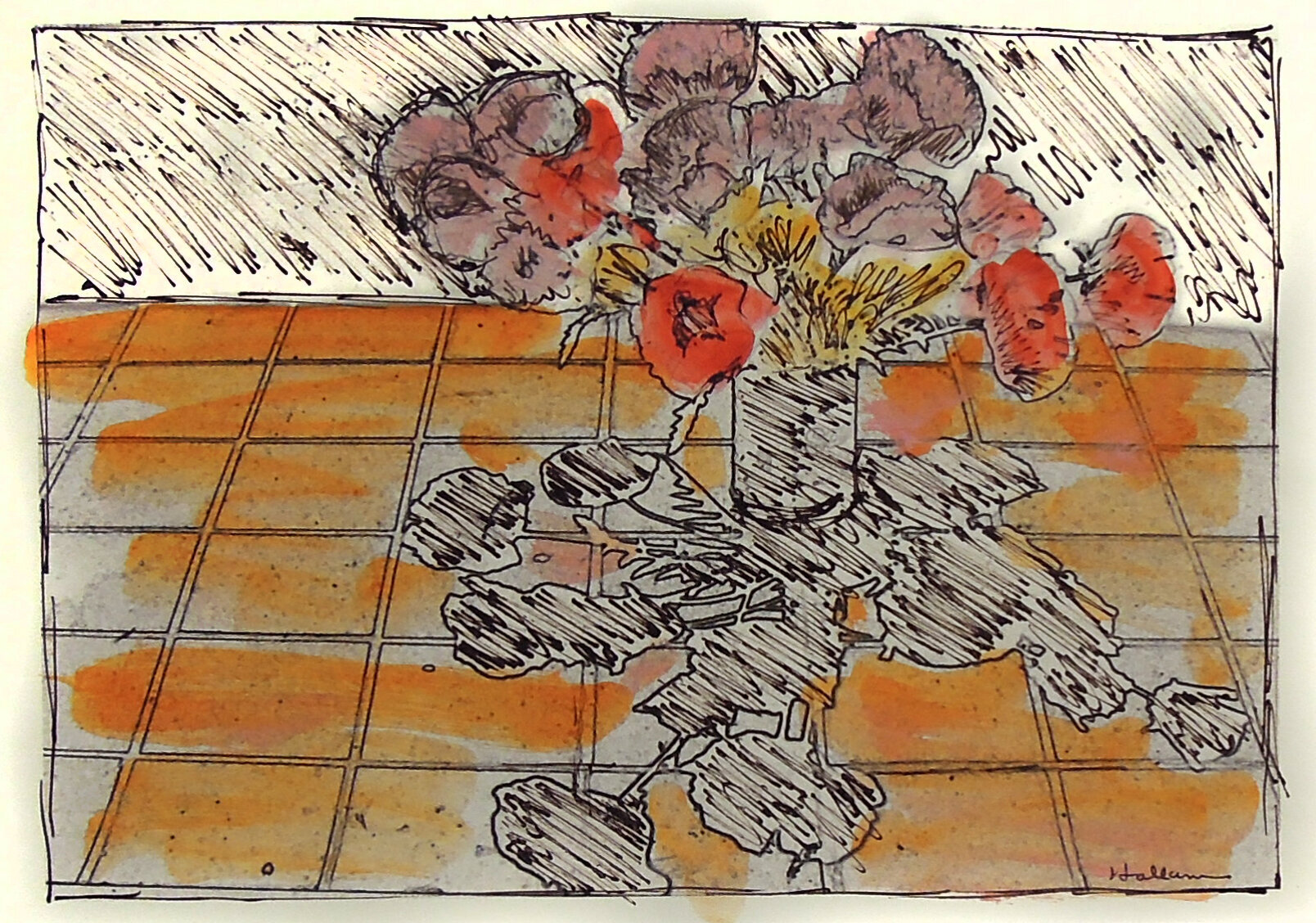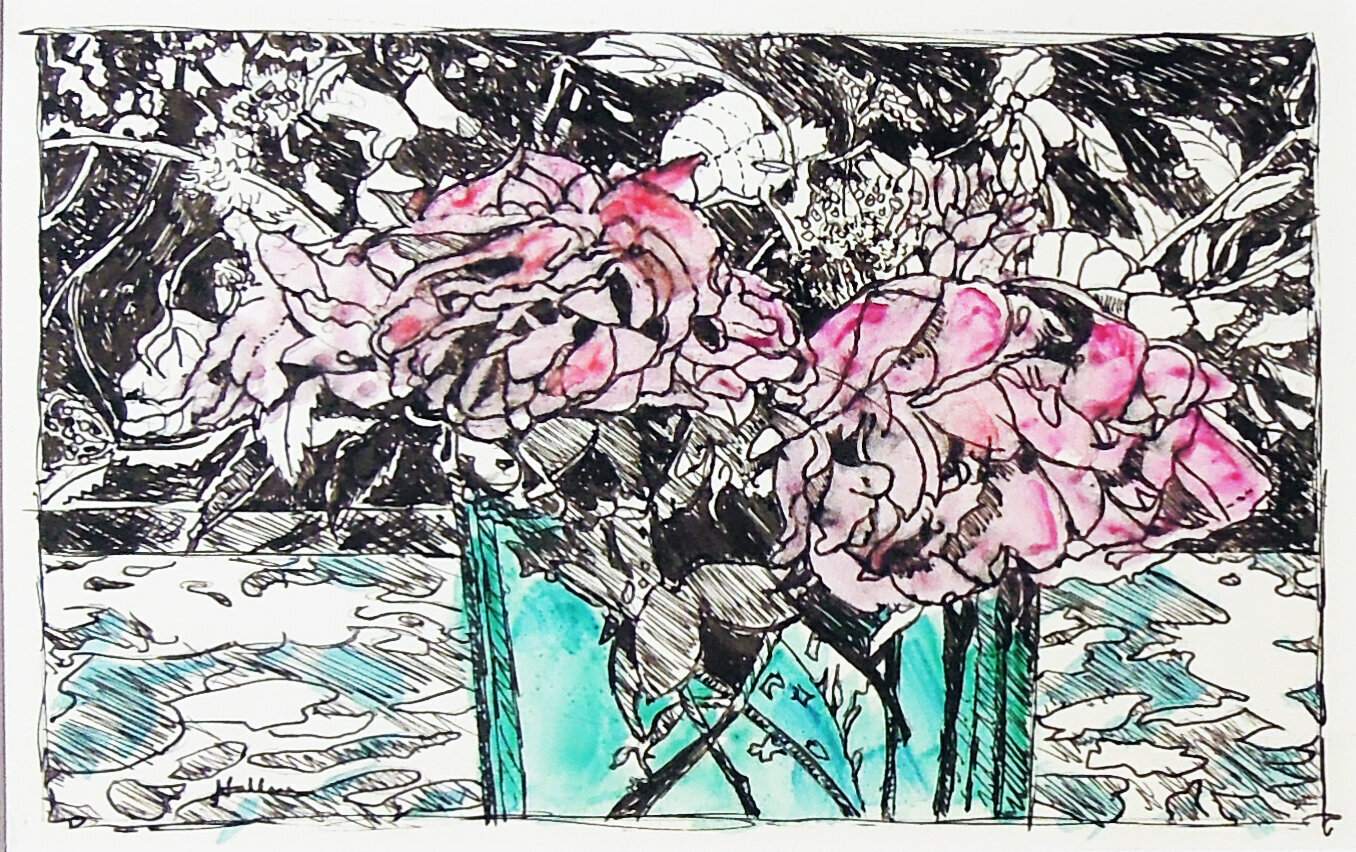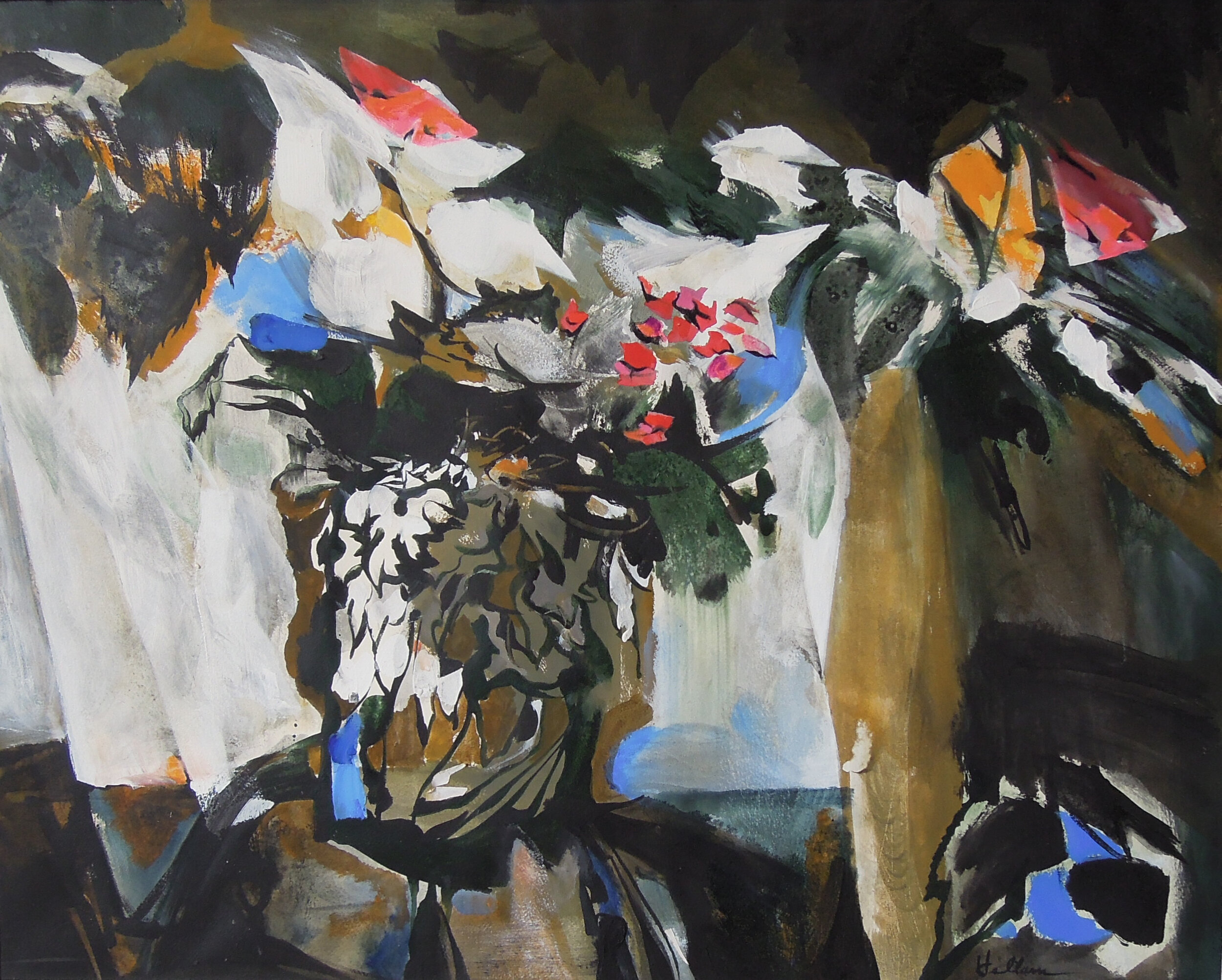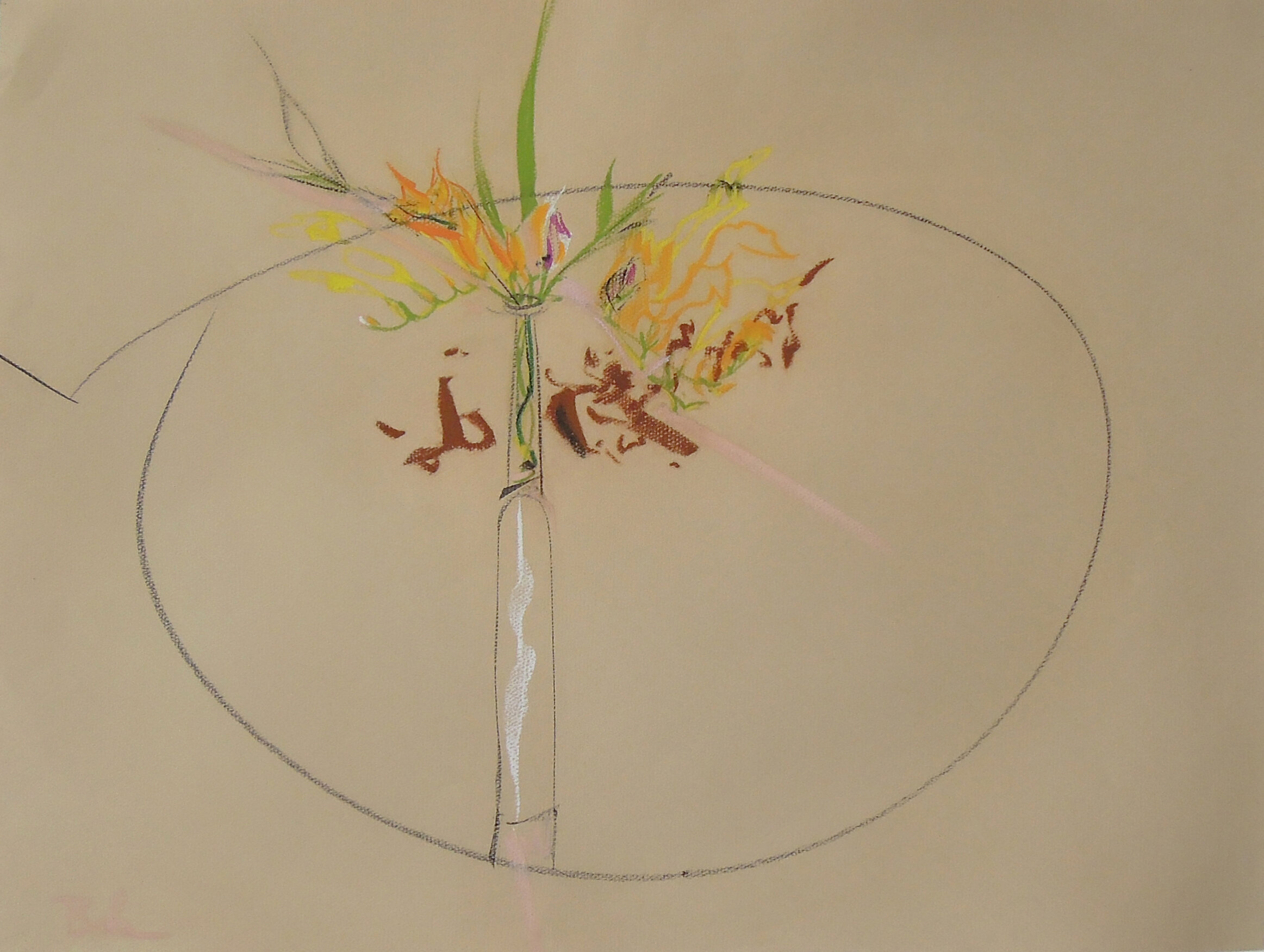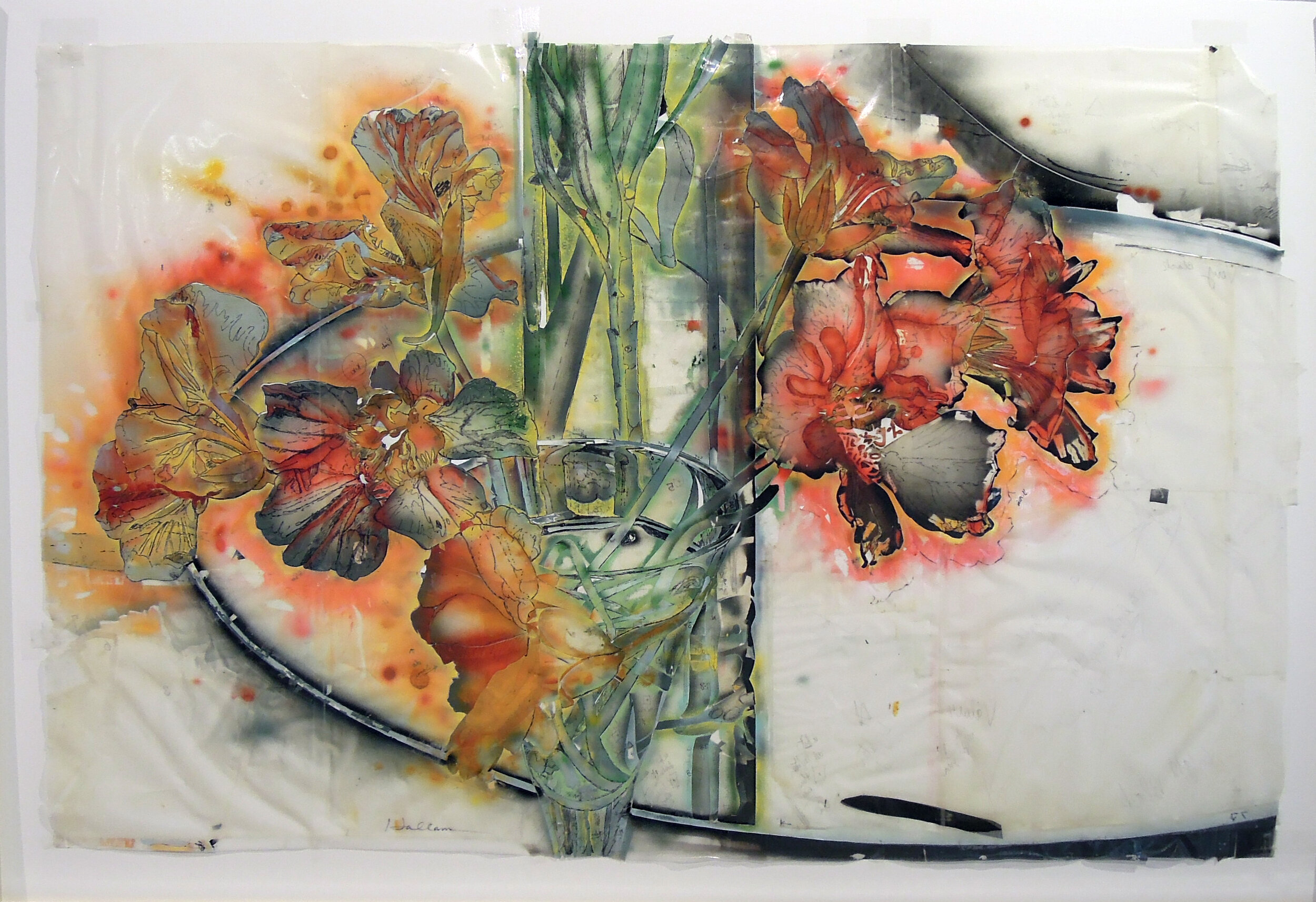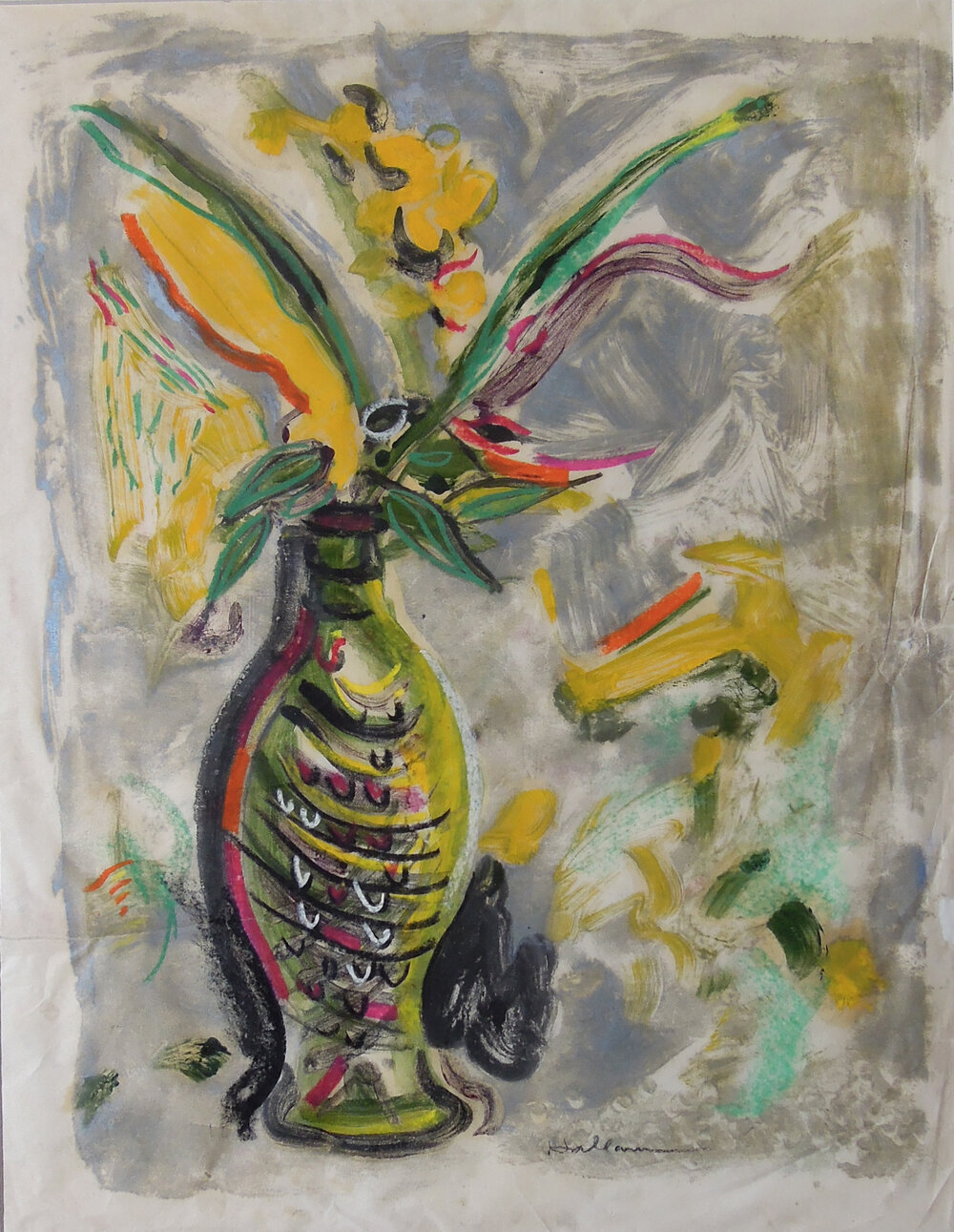"Surf's Up," Decor Maine, June 2023
Profile of Surf Point Foundation by Allison Paige in Decor Maine’s June 2023 Art Issue.




"Diversity of contemporary art scene demonstrated by 3 shows," Portland Press Herald, May 2023
Jorge Arango’s review of Surf Point Foundation’s first alumni exhibition, “SPF Selects: A More Human Dwelling Place” at the George Marshall Store Gallery, featured in the Portland Press Herald.

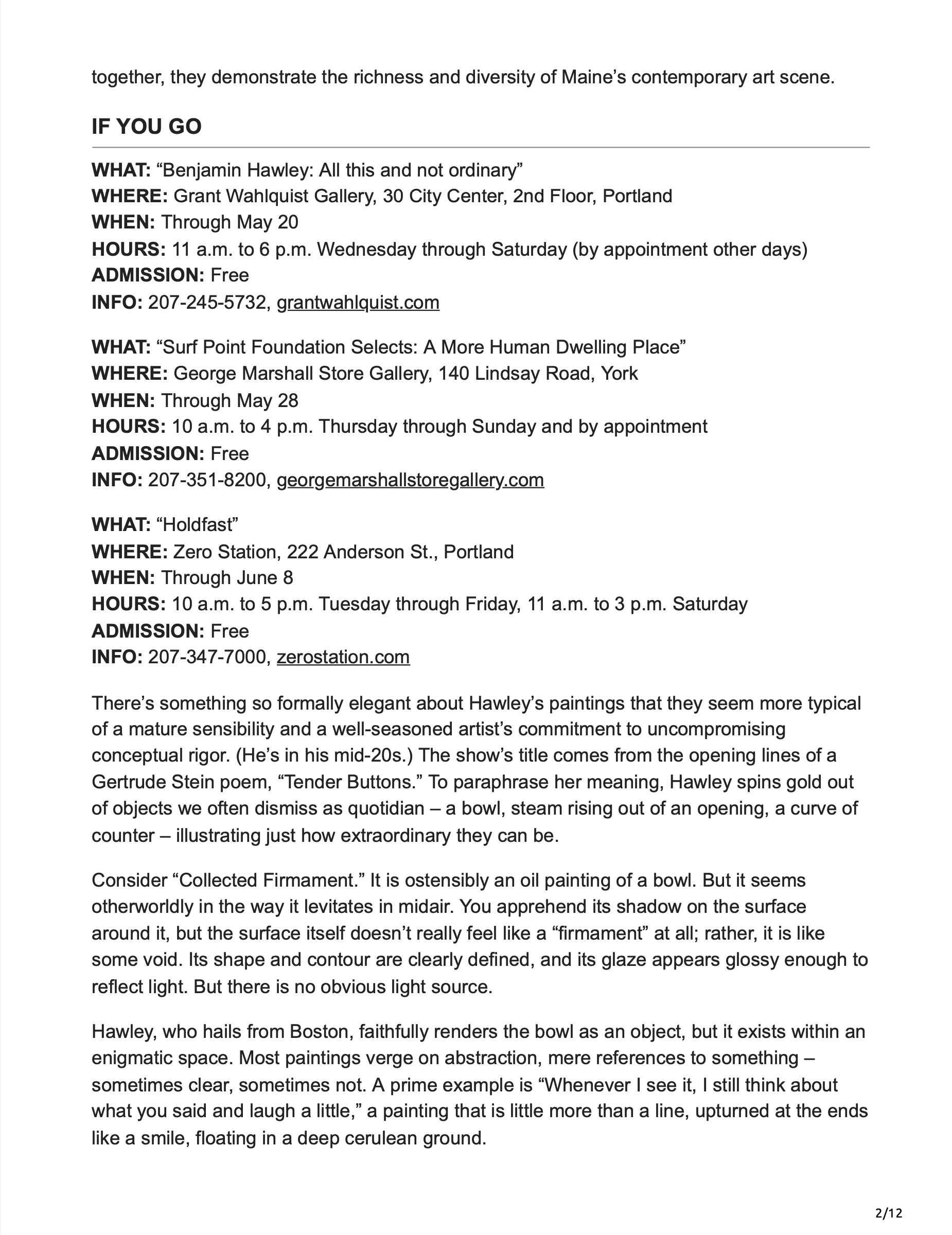
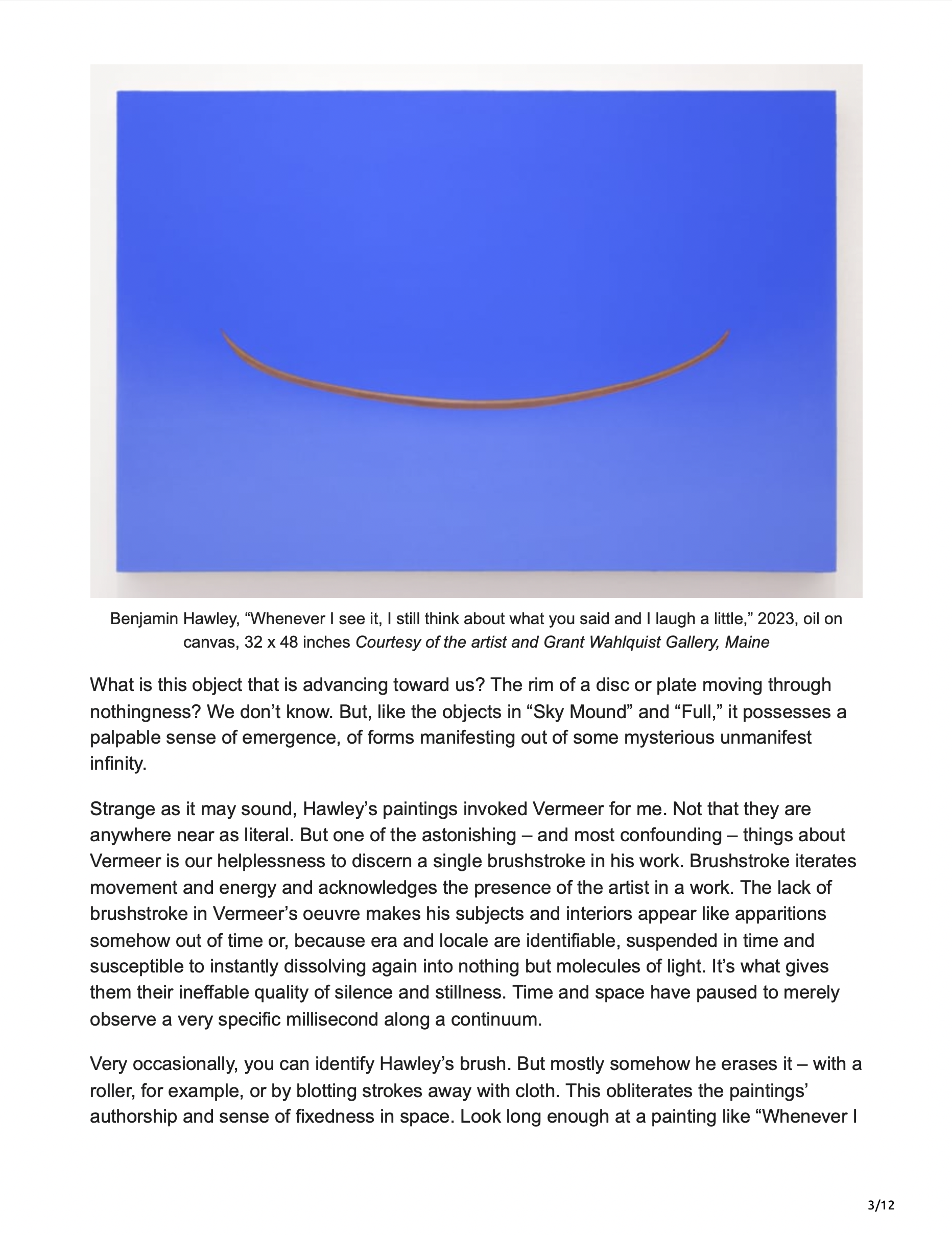
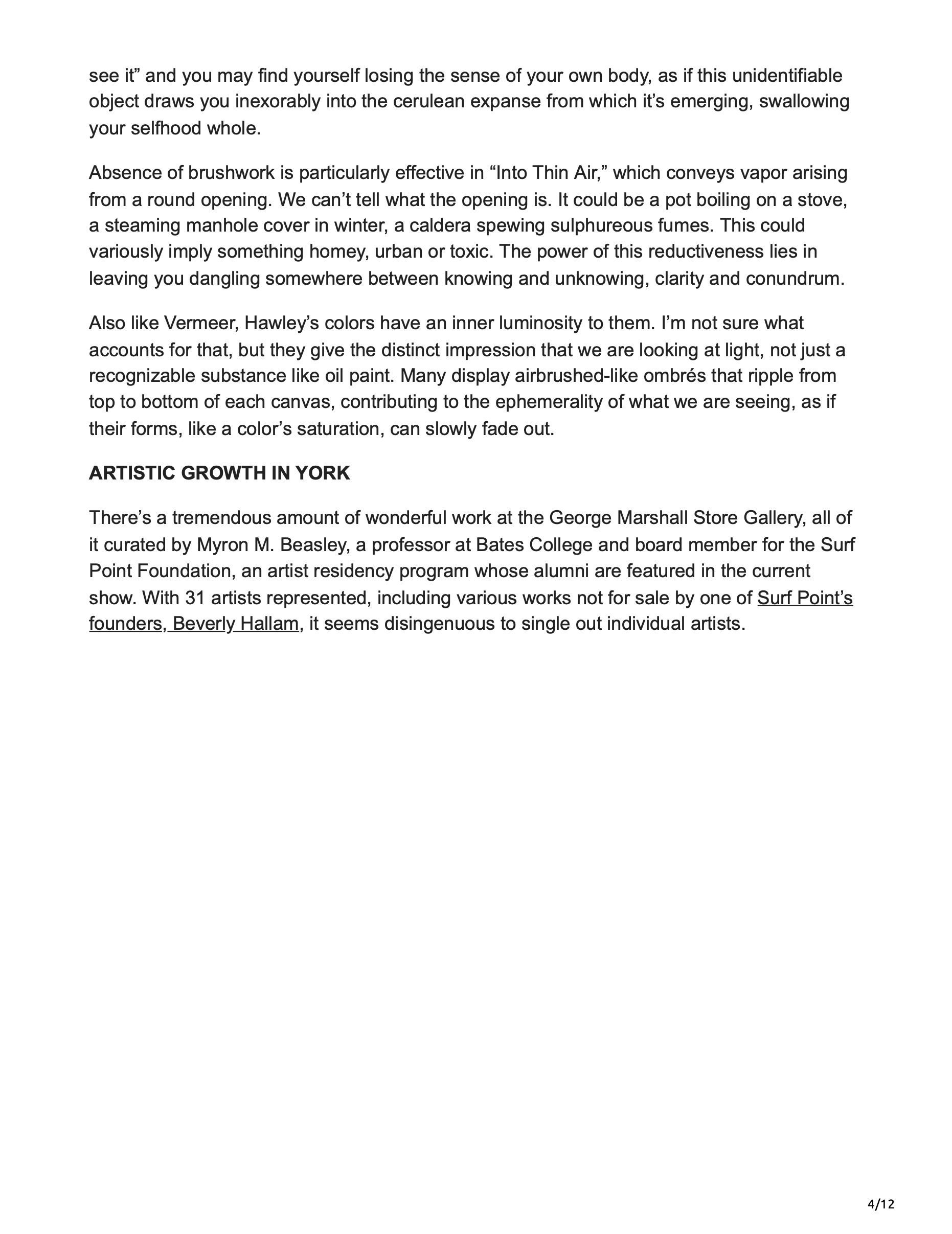
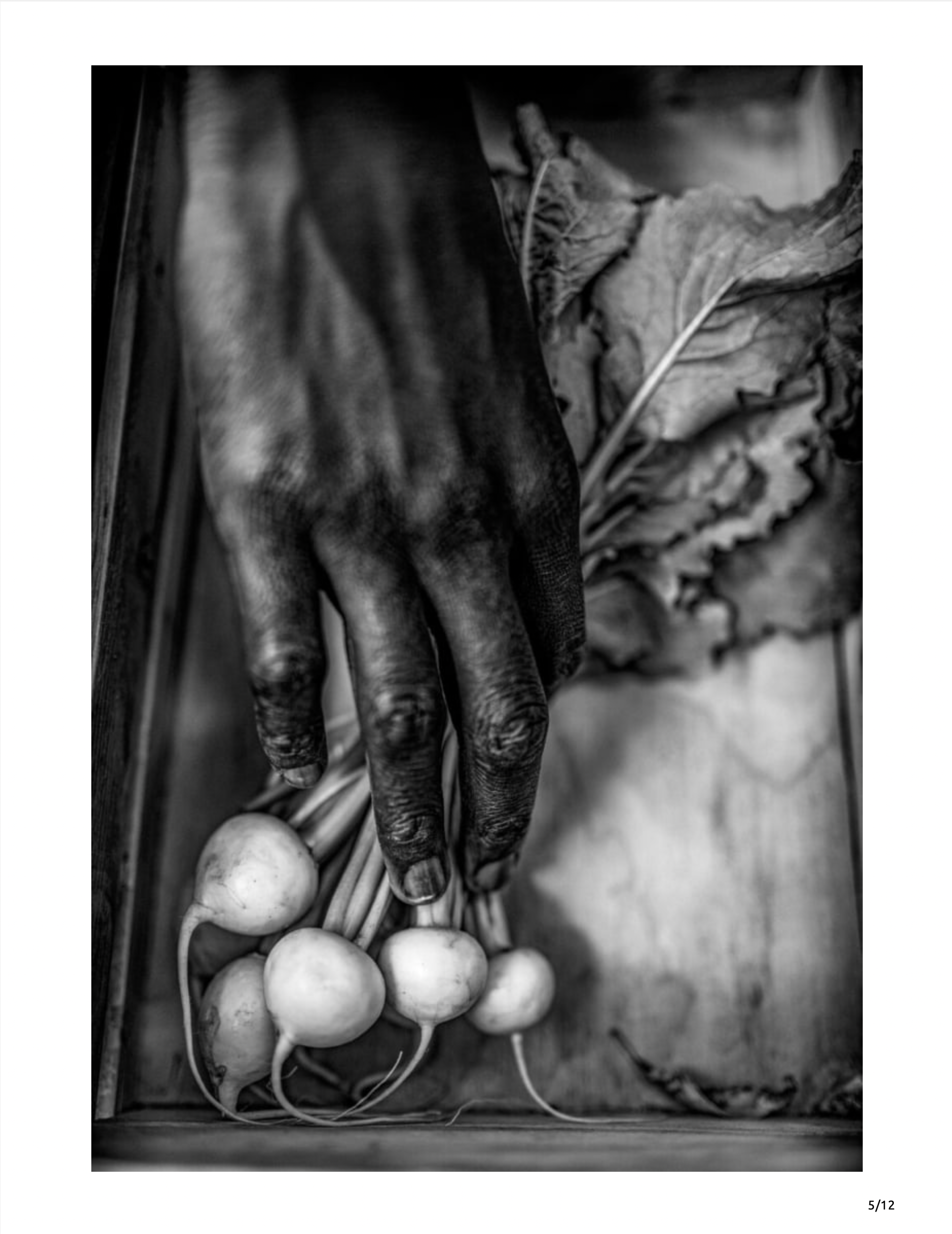

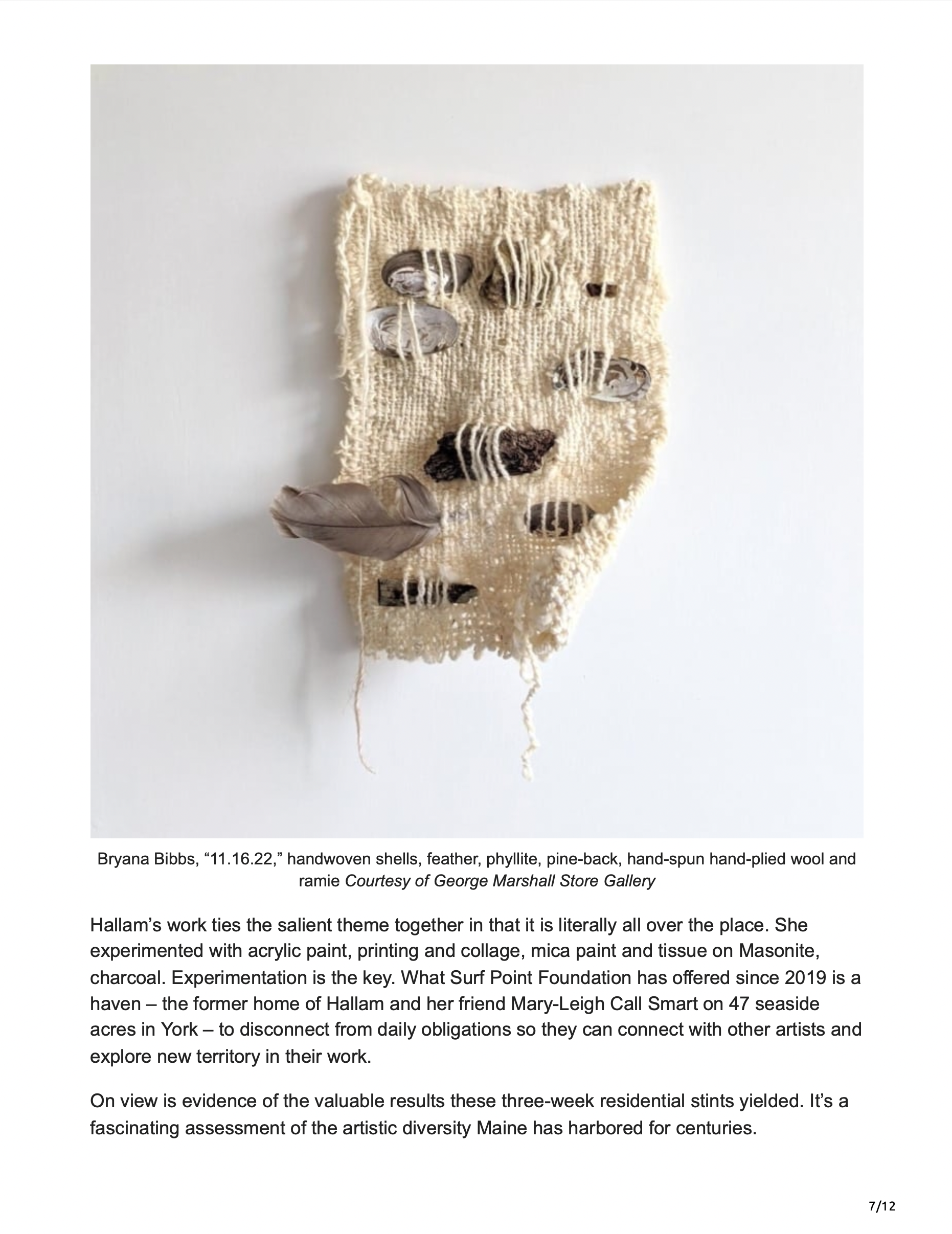
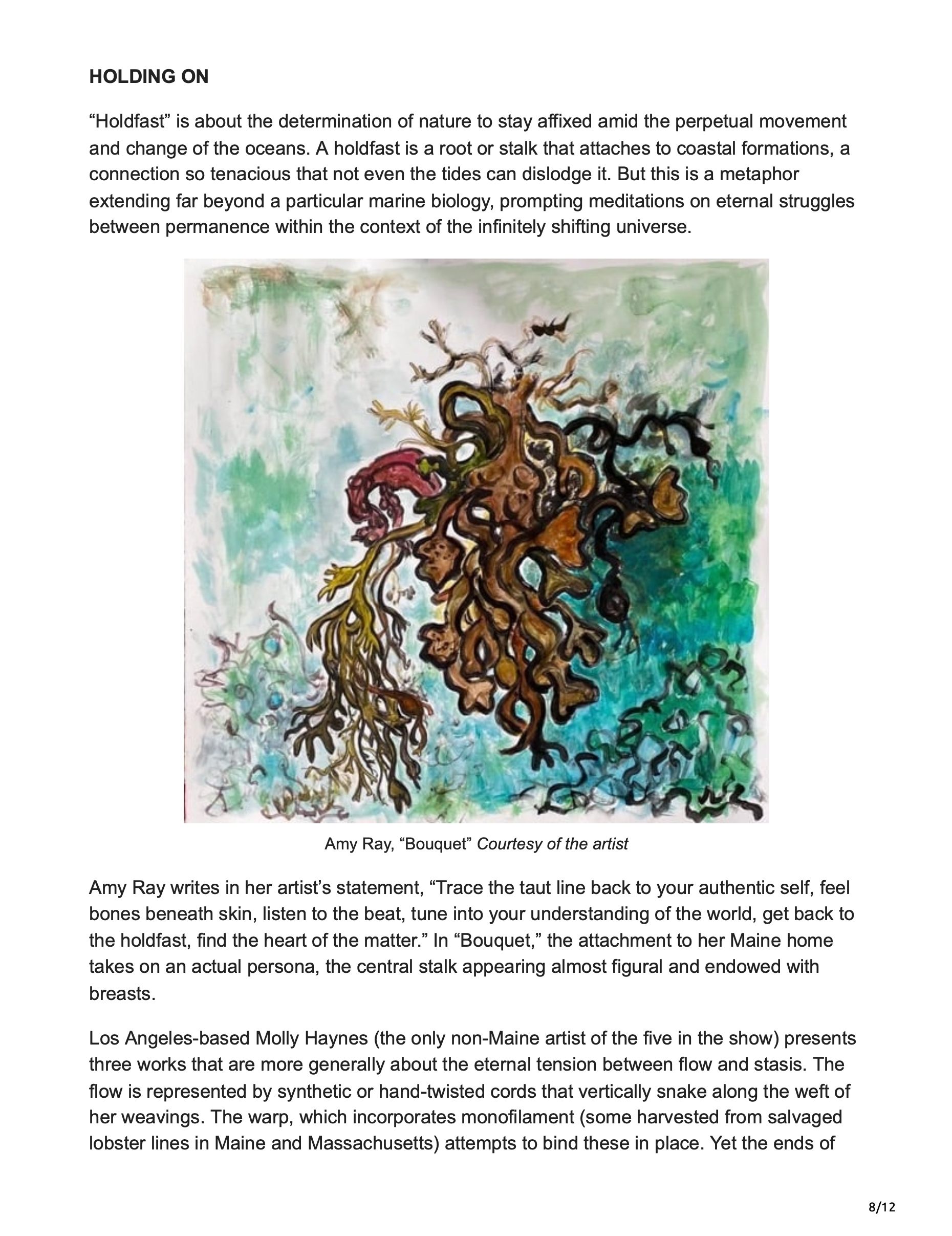

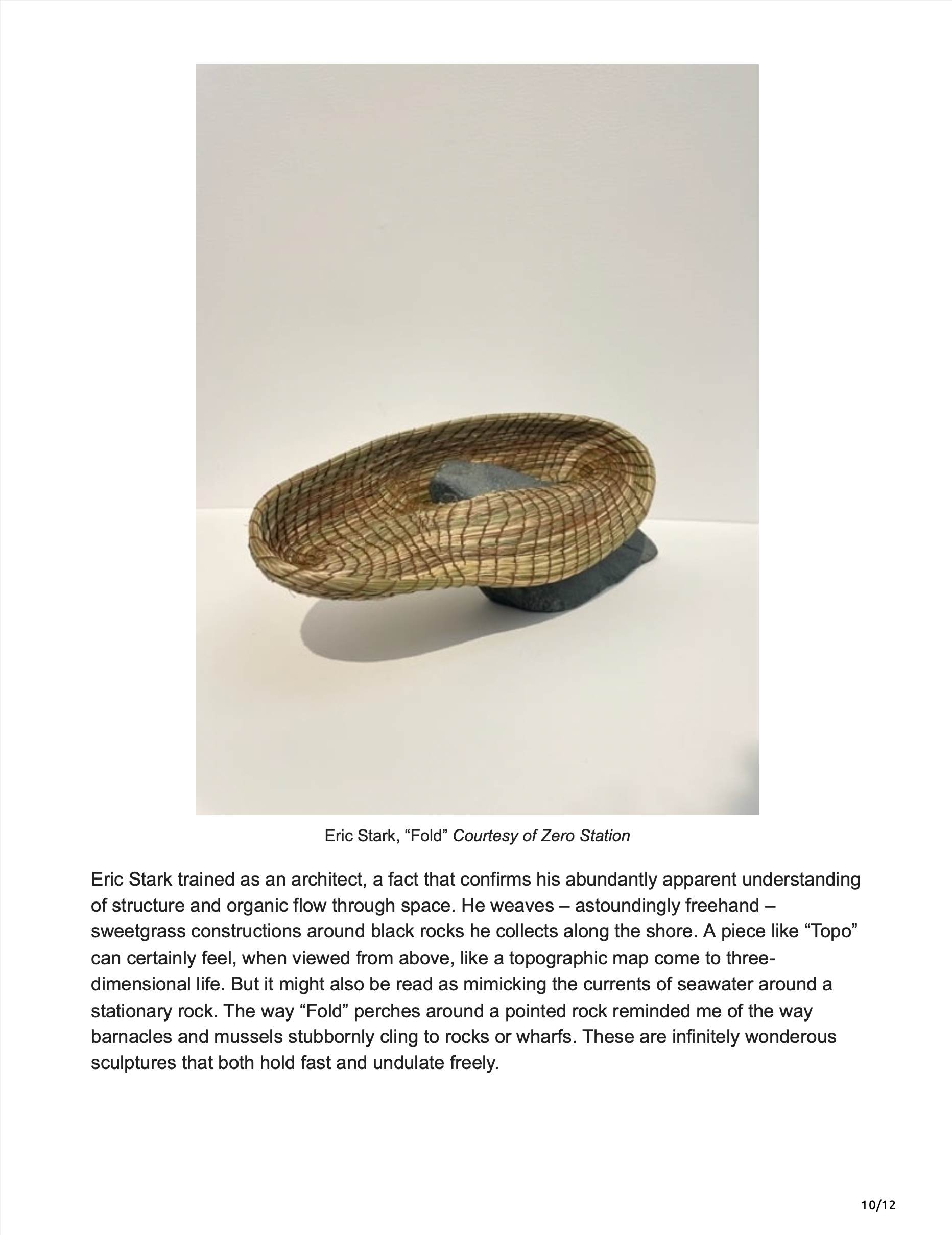
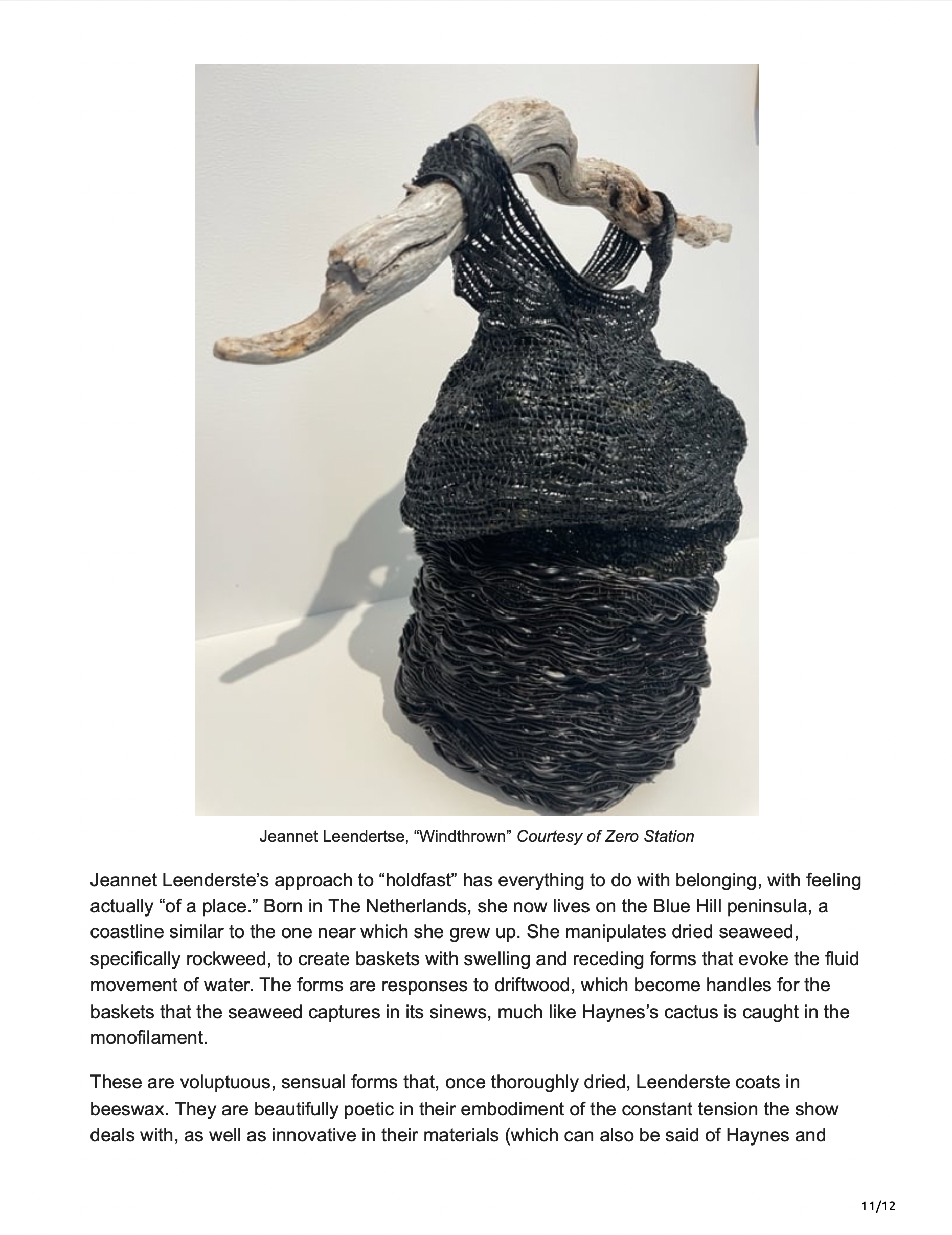
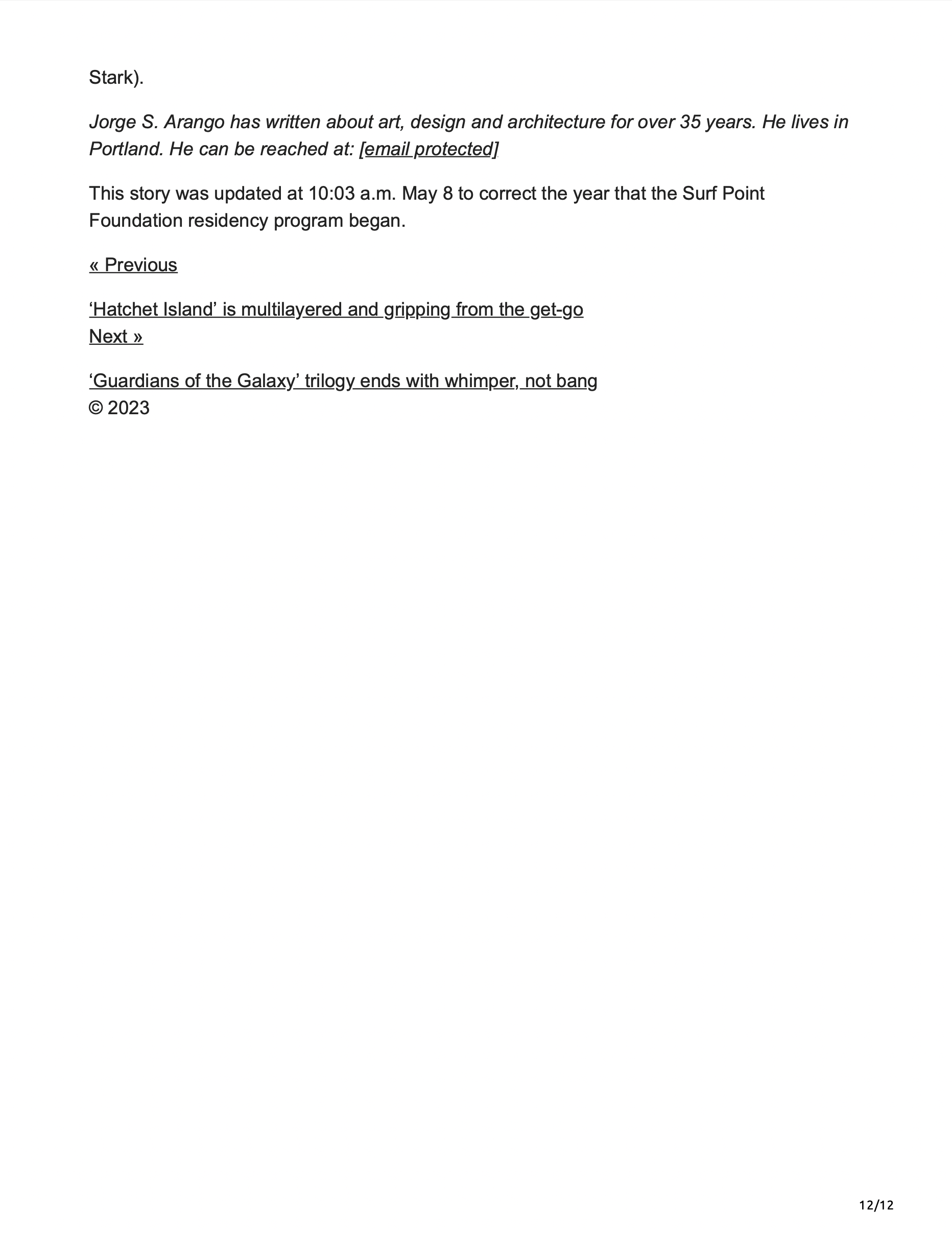
"11 Maine Residencies Where the Arts Thrive," Downeast, May 2023
Surf Point Foundation featured in Downeast’s "11 Maine Residencies Where the Arts Thrive," May 2023.

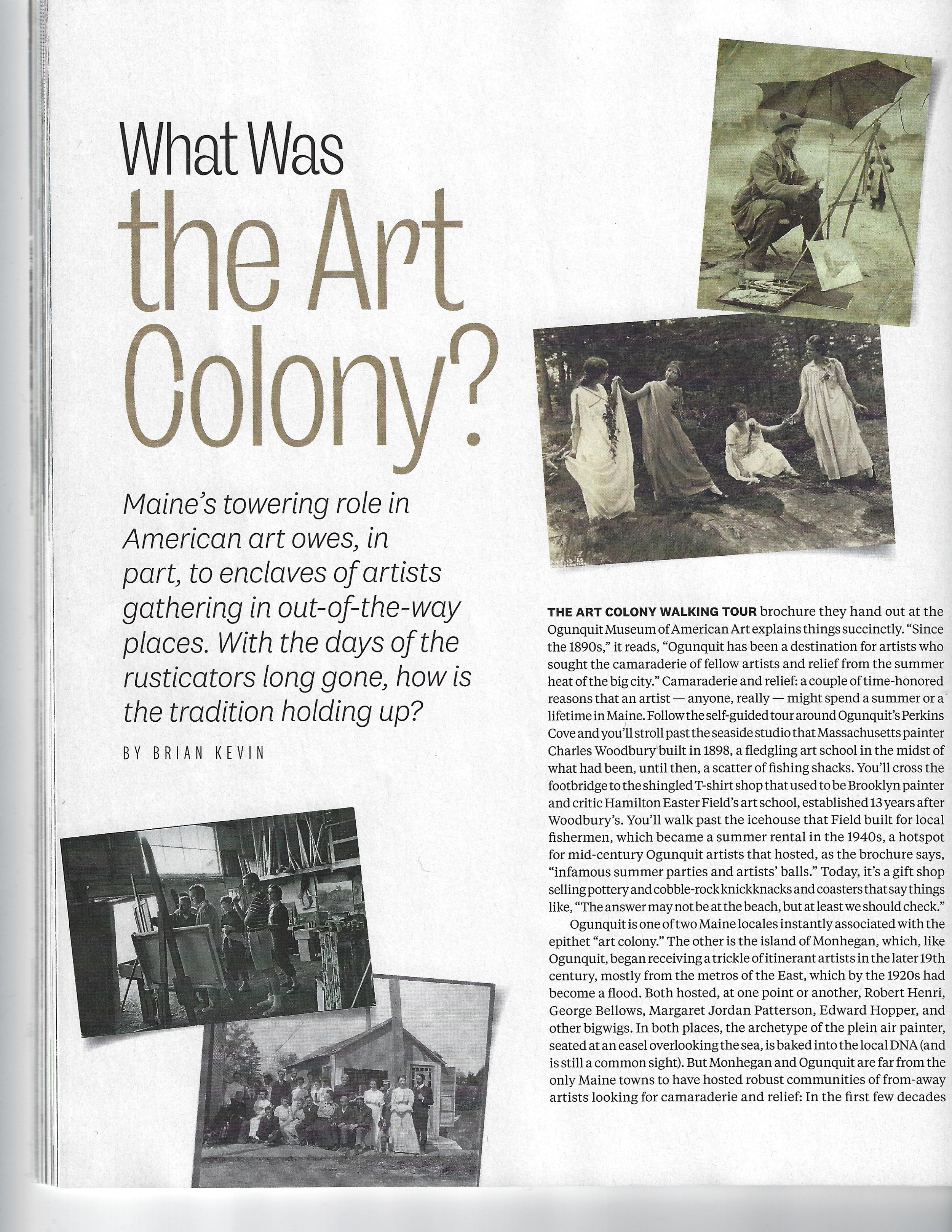
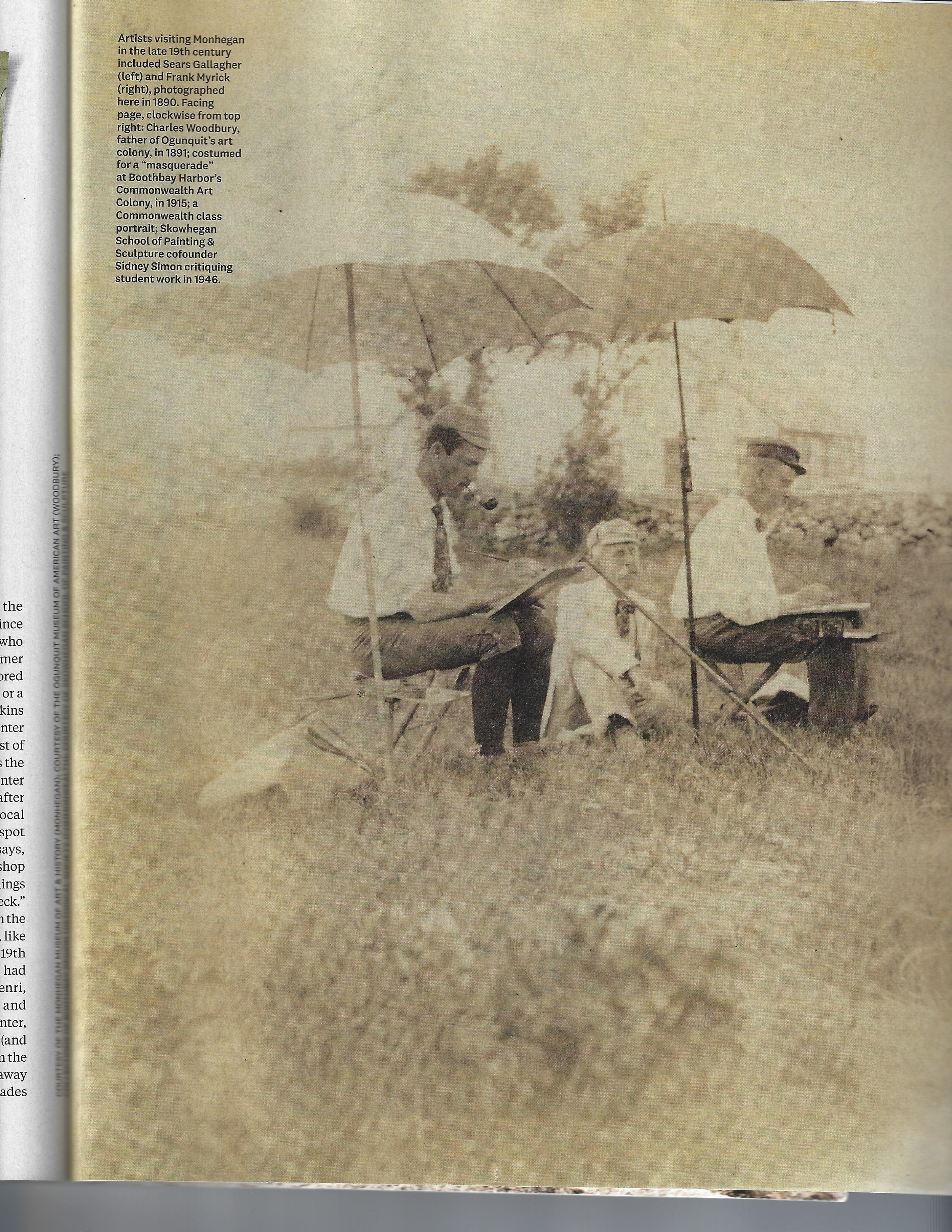

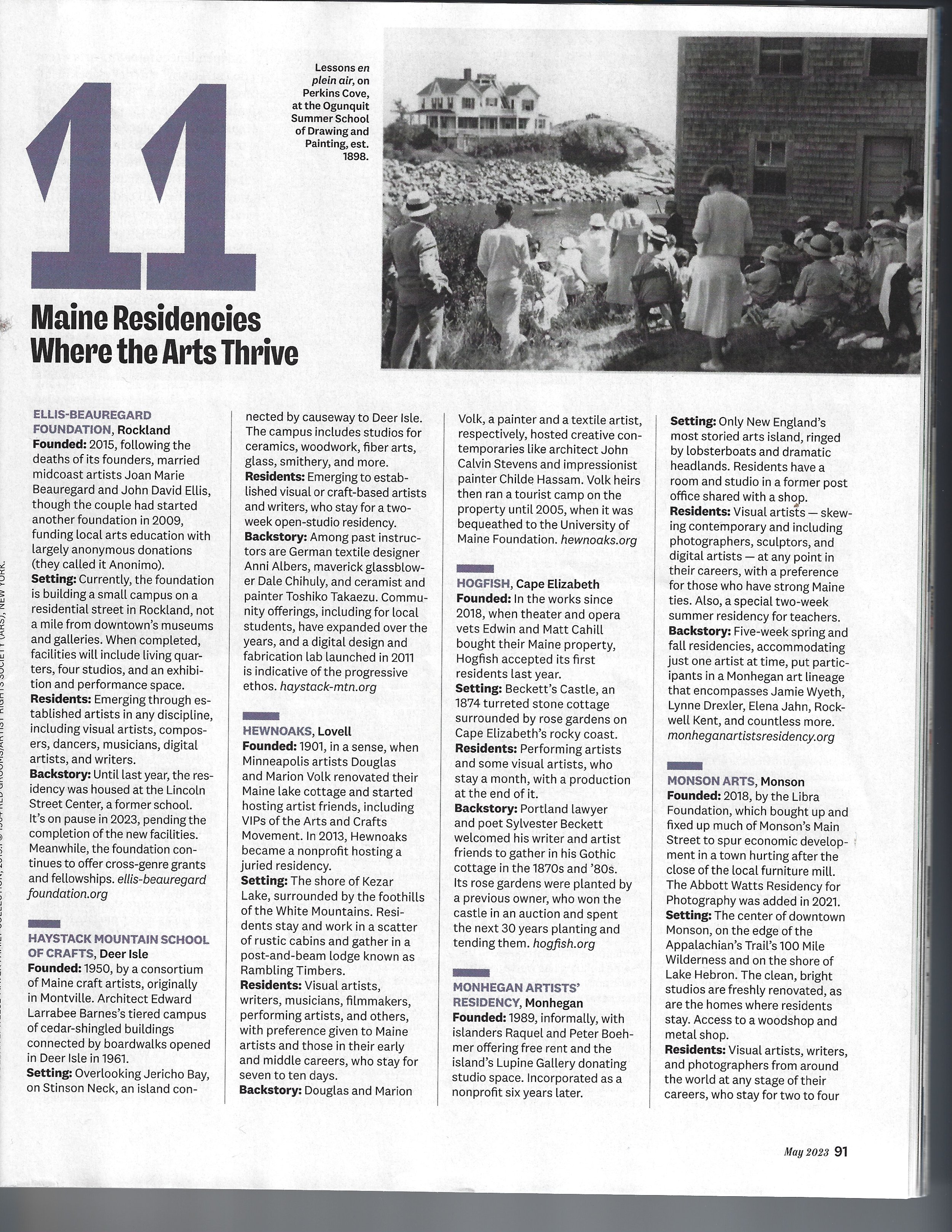
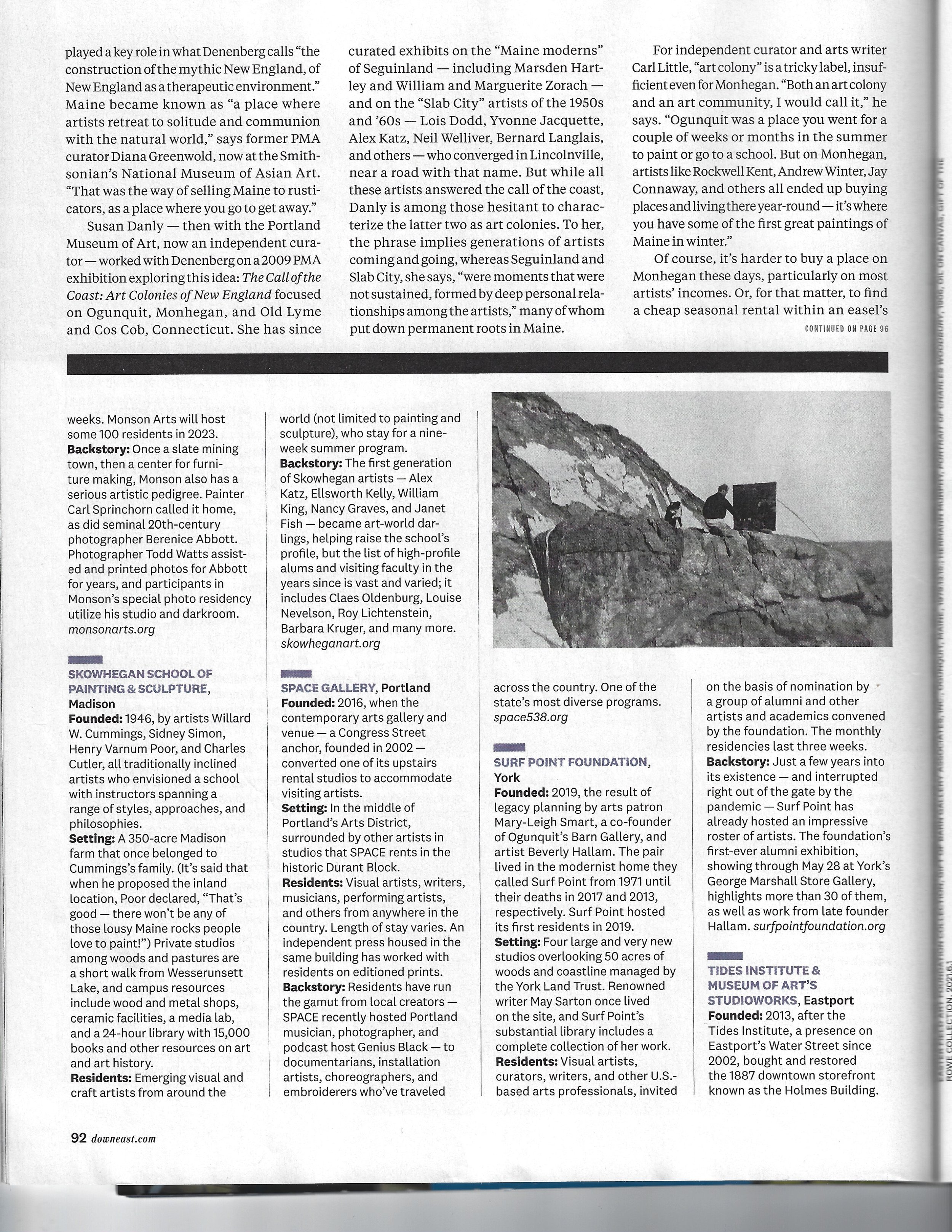
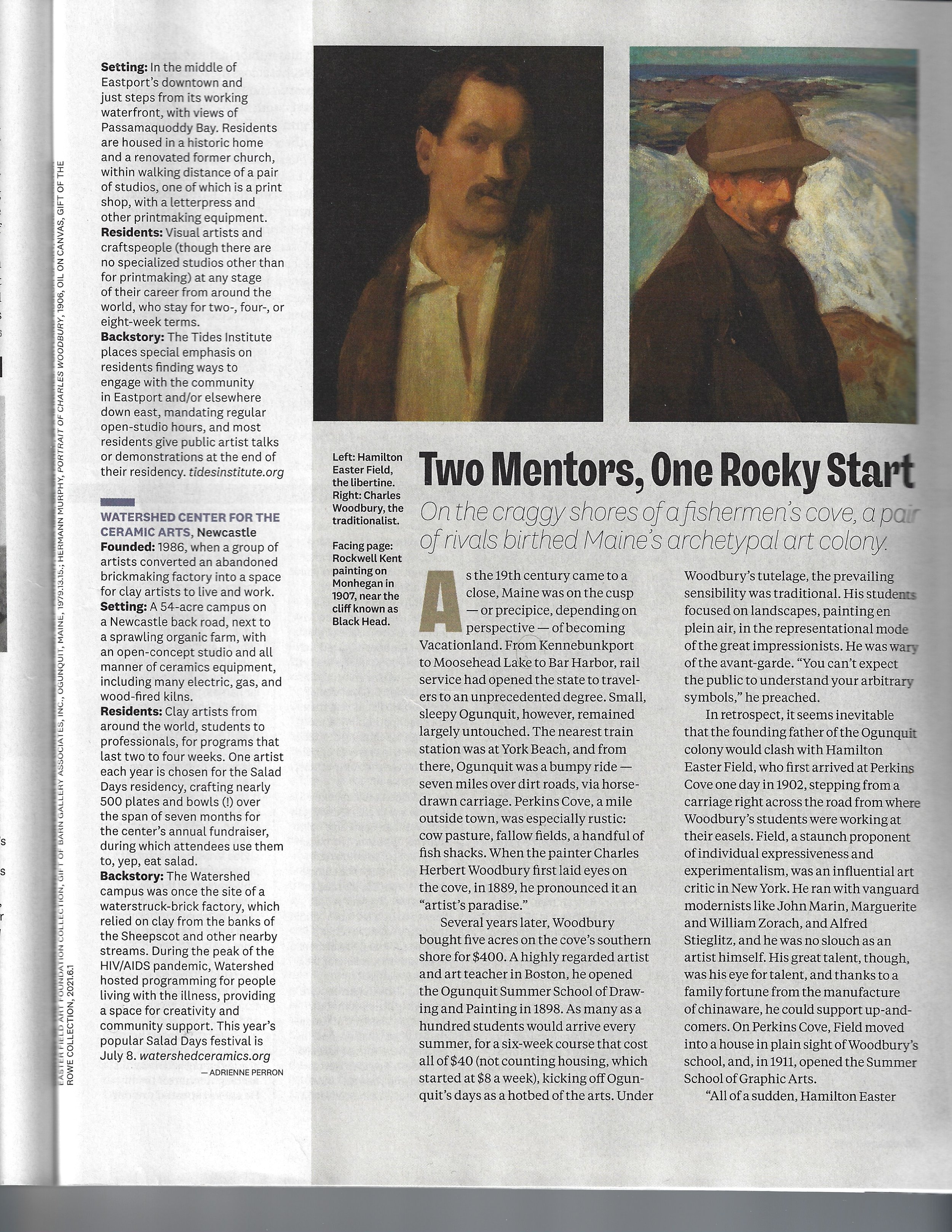
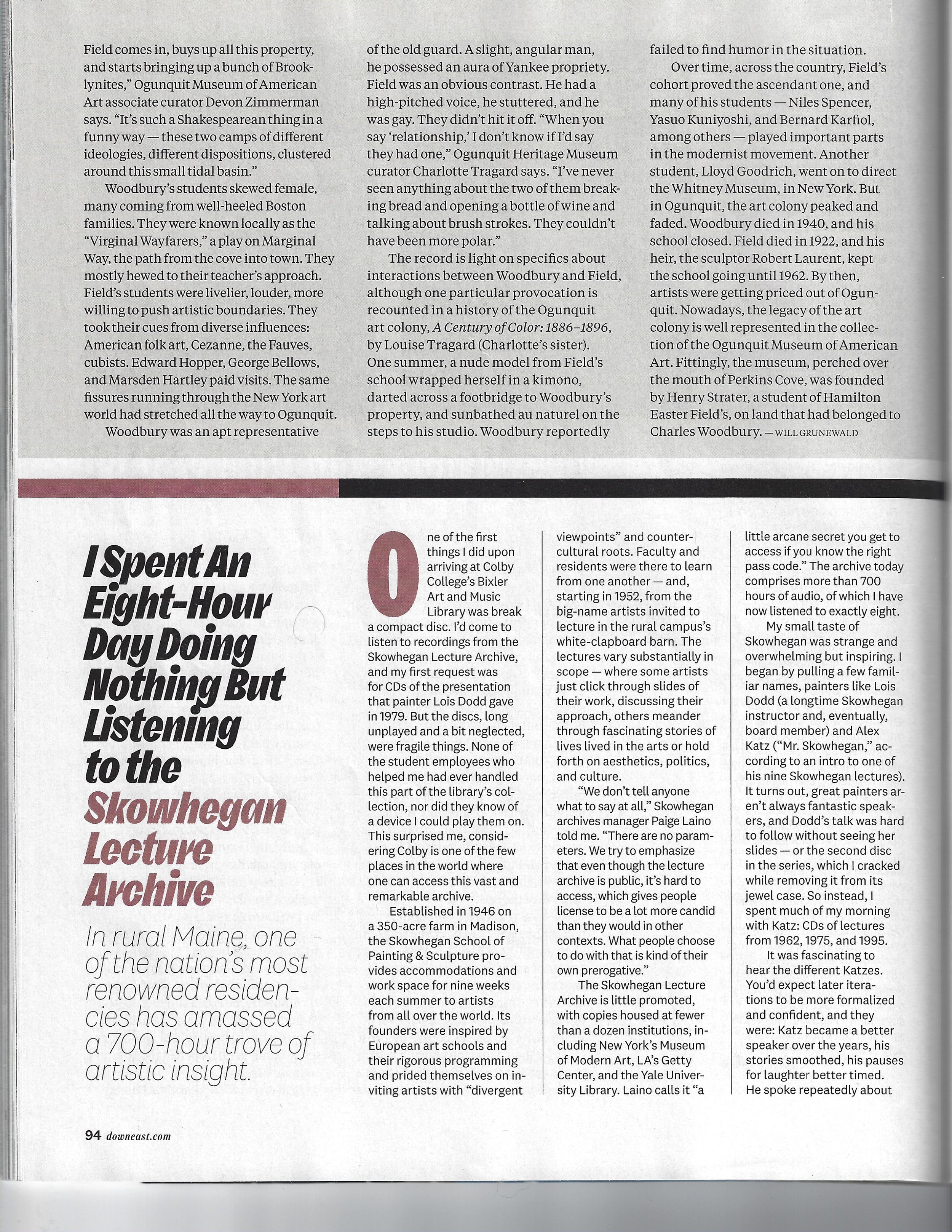
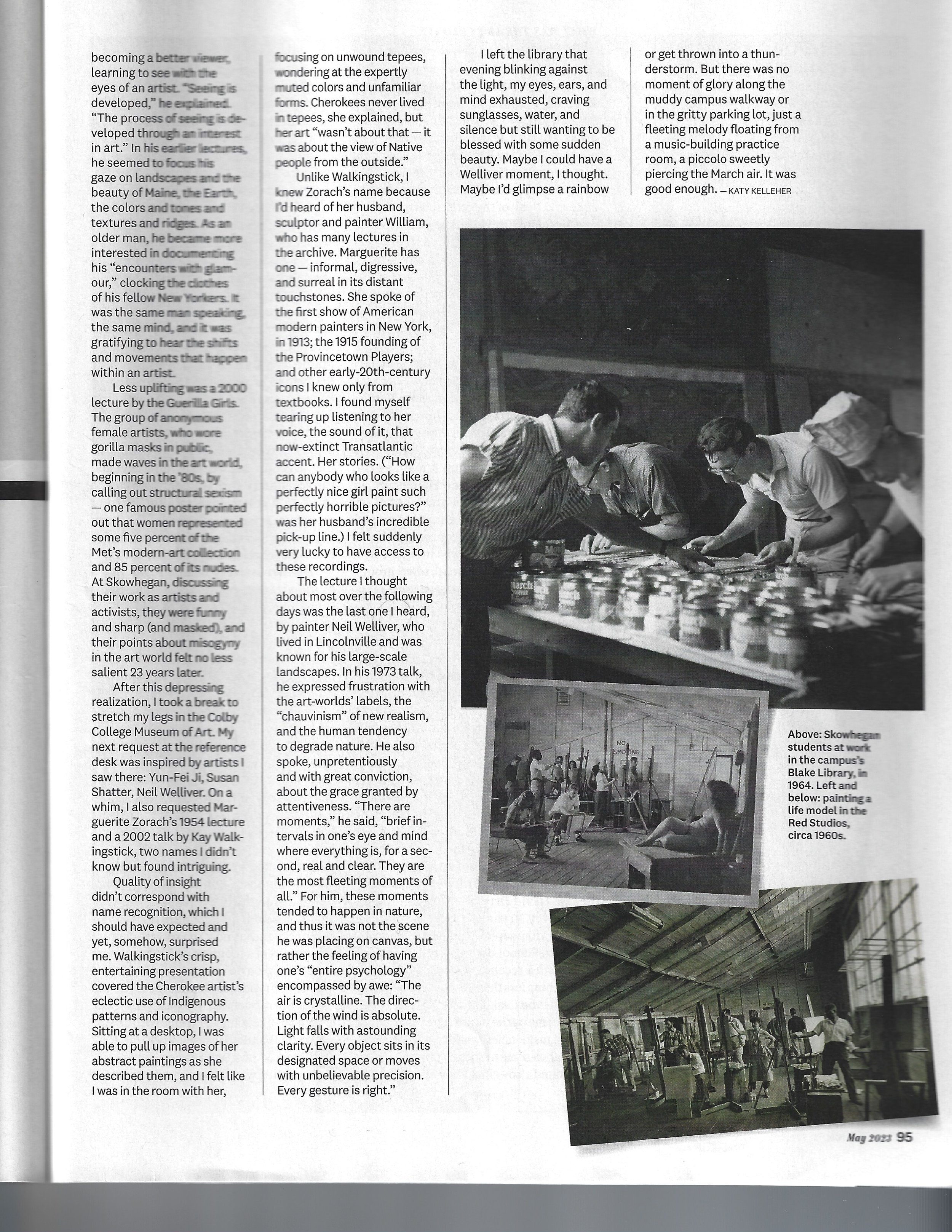
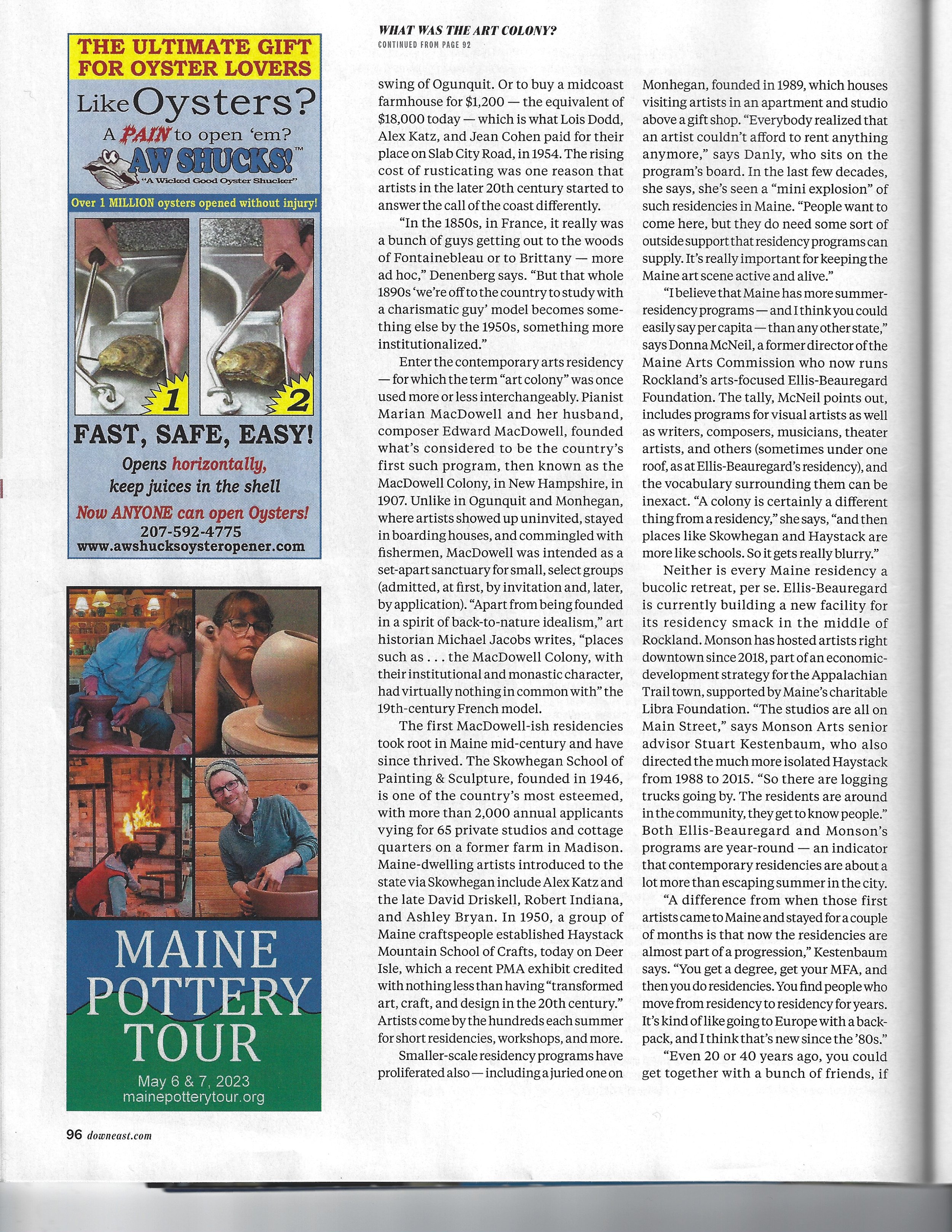

Wild Knoll History
In her 1977 memoir The House by the Sea, May Sarton described her first visit to the 1916 Colonial Revival in York that she would call home for the last 22 years of her life. “Once I stood on that wide flagstone terrace,” she wrote, “and looked out over that immensely gentle field to a shining, still blue expanse, the decision was out of my hands.”
Image by Greta Rybus
Photos of Wild Knoll by Cole Caswell












FAREWELL TO MAY SARTON'S "HOUSE BY THE SEA"
April 23, 2021
By Bridget M. Burns, Downeast Magazine, February 2021.
In her 1977 memoir The House by the Sea, May Sarton described her first visit to the 1916 Colonial Revival in York that she would call home for the last 22 years of her life. “Once I stood on that wide flagstone terrace,” she wrote, “and looked out over that immensely gentle field to a shining, still blue expanse, the decision was out of my hands.”
The house she called Wild Knoll was demolished this winter, dismantled over three days in November, to the disappointment of some of Sarton’s readers and admirers. The author of 16 books of poetry, 19 novels, and 12 memoirs and published journals, Sarton, who died in 1995, was one of Maine’s most prolific literary figures. She rented Wild Knoll from friend and arts patron Mary-Leigh Smart, who lived next door and died in 2017, willing that her 47-acre property, called Surf Point, be converted to an artist colony after her death. The Surf Point Foundation, which began offering residencies to artists in 2019, met pushback from those who hoped to see Sarton’s home preserved, but executive director Yael Reinharz says the costs of repairing and maintaining the aging house were insurmountable.
“I think the initial feelings of many people were feelings of distress,” Reinharz says. But the modestly endowed foundation faced costs for structural repairs, a new septic system, and the replacement of windows, siding, insulation, and more. Reinharz is confident the loss of Wild Knoll won’t affect the public’s remembrance of Sarton. “I think the people who know the most about her work are very well prepared to continue to foster that legacy,” she says. Meanwhile, the flagstone terrace remains, a spot where resident artists can look out over the blue expanse, as Sarton once did.
View from Wild Knoll
WILD KNOLL
November 4, 2020
Surf Point Foundation invests in visual artists and those who amplify their work through a diverse, inclusive and accessible residency program on the coast of York, Maine. Our mission realizes the vision of our founders, the late arts patron Mary-Leigh Smart and artist Beverly Hallam.
The Foundation has reached a difficult decision, and we want our neighbors, the town of York, and those in the broader arts, cultural and historic preservation communities to understand the circumstances and reasoning behind it.
Over the last four years, the Foundation has invested in preserving and renovating “Surf Point,” built and lived in by Mary-Leigh and Beverly for nearly 50 years. This 6,000sf home, transformed into a cultural facility, now offers four live-work spaces to artists and arts professionals for three-week-long sessions year-round.
We have been guided by a commitment to honor the spirit of our founders, who contributed their home, land, art and legacy to Surf Point, and who wanted to build a retreat for artistic creation and connection with nature.
Integrated with the Foundation’s mission, our conservation easement, managed by the York Land Trust, ensures a minimal human footprint on our 47 acres of land.
A second building, known as “Wild Knoll,” also sits on the Foundation’s property. Esteemed writer and poet May Sarton rented, lived and worked at Wild Knoll from 1973-1995. When the Foundation assumed ownership of the building in 2017, it found the building in disrepair, and invested significant time and resources to determine the feasibility and cost of renovations.
Among the many obstacles: mitigation of hazardous materials; replacement and updating of windows, siding, insulation, electrical, HVAC, and septic systems; structural repairs; and reconfiguration for safety, accessibility and privacy.
The cost of such a renovation - combined with the continuing costs of maintaining, managing and programming the building - far exceed the Foundation’s capacity, which has one staff person and a commitment to its primary mission to serve artists and art professionals through the residency program. The Foundation is not equipped to raise the significant sums needed for such an undertaking. We must be organizationally, financially, and ecologically sustainable in order to fulfill the mission envisioned by our founders.
Given all of these factors, the Foundation board made the decision to take the building down, with no proposed future use for the site.
This decision was difficult, knowing that both historic preservation and the life and work of May Sarton are important to the Foundation and members of the community.
We are committed to continuing conversations about our mission and common interests with one and all, including organizations such as the York Land Trust, Old York Historical Society, the York Historic District Commission, Maine Preservation, the York Community Services Association, the George Marshall Store Gallery, and with town residents.
We value our role as a participant in the cultural community, and hope we have provided context for our decision.
Sincerely,
Executive Director Yael Reinharz and the Surf Point Foundation Board
Floriography: The Language of Flowers - Beverly Hallam Exhibited at Cove Street Arts
Originally conceived as an early April show, as both an antidote to the cruelest month’s lingering gloom, and a reminder that spring, with its florid proliferation of life, was on the horizon, Floriography feels even more timely in its new slot as our first post-lockdown exhibition.
Originally conceived as an early April show, as both an antidote to the cruelest month’s lingering gloom, and a reminder that spring, with its florid proliferation of life, was on the horizon, Floriography feels even more timely in its new slot as our first post-lockdown exhibition.
Its message more immediate, urgent, and life-affirming… This exhibition presents a conversation between the work of four talented and stylistically diverse female artists, each in dialogue with her subject matter, with her media and the act of mark-making, and with floral painting as historical genre.
The exhibition also includes a selection of works on paper from the estate of Maine Master and nationally known pioneering postwar female artist, Beverly Hallam. These works span from 1961 to 2007, and media include pastel, acrylic, ink, oil monotype and charcoal. They beautifully display the artist’s verve and virtuosity as well as her enduring fascination for floral still lifes.
BEVERLY LINNEY HALLAM
November 22, 1923 - February 21, 2013
Beverly Hallam was born in Lynn, Mass. on Nov. 22, 1923, the daughter of Alice Linney Murphy and Edwin Francis Hallam. She graduated from Lynn English High School. During her early years, she studied clarinet and saxophone. In 1945, Hallam received a B.S. Ed. from the Massachusetts College of Art and in that year she received a position at Lasell Junior College (Auburndale, MA) where she was Chairman of the Art Department until 1949. Following coursework at Cranbrook Academy in 1948, she received her M.F.A. from Syracuse University in 1953.
From 1949-1962, Hallam was professor at the Massachusetts College of Art where she taught Painting, Drawing and Design. There, she taught the first courses in Photography and Theater Arts, and led students to experiment with avant-garde effects in set painting, costume design, lighting, projection, and taped electronic music. She supervised the Saturday Morning High School Art Classes.
An avid photographer, Ms. Hallam travelled to Europe and compiled many illustrated lectures on art subjects which she gave throughout the country. From the early 1950s, Hallam was one of the earliest artist-adopters in the U.S. of Polyvinyl Acetate—or Acrylic—now ubiquitously recognized as a fine art medium. Known for her large airbrushed flower canvases and for experimental printmaking, Hallam had 45 solo exhibitions in museums and galleries and participated in 280 group shows. Her work is in the permanent collections of many museums and corporations and in private collections in the U.S., Canada, France, Belgium, and Switzerland—including those of the Harvard Art Museums, Farnsworth Art Museum, Ogunquit Museum of American Art and National Museum of Women in the Arts.
Although she taught full time, Hallam never gave up painting. Over the course of a practice that spanned 56 years, she experimented with media and approaches, ever open to new ideas and technical approaches to making. In 1963, Hallam resigned from teaching to live and work full time in Maine, first in Ogunquit and then in York.
Hallam had gallery affiliations in Boston, Chicago, Dallas, Florida, and Maine. Her exhibition history included retrospectives at the Addison Gallery of American Art (1971) and at the Farnsworth Art Museum, Rockland (1998). In that same year, Midtown Galleries in New York mounted a large traveling exhibition focused on Hallam’s innovative use of airbrush, and Carl Little’s monograph Beverly Hallam: An Odyssey in Art was published. In 1990, the Evansville Museum of Arts and Science compiled an exhibition in Indiana that toured to five other states. Her work was recognized with several awards, including "Distinguished Alumni Award, Massachusetts College of Art" and "Maine College of Art Award for Achievement as a Visual Artist." The Union of Maine Visual Artists, as part of the Maine Masters Project featured her brilliant career on film in Beverly Hallam: Artist as Innovator in 2011, directed by Richard Kane.
Hallam maintained an active studio at Surf Point until her death on February 21, 2013. Her papers are held in the Archives of American Art, Smithsonian Institution. Her legacy includes the conception, with friend and patron Mary-Leigh Smart, of Surf Point Foundation, whose mission is to be an inclusive residency program in their former home on the York coast.
Maine Artists Are Taking Their Legacies Into Their Own Hands
Hallam and Smart were far ahead of the trend. Although the residency program didn’t begin operating until this fall, they created the Surf Point Foundation in 1988 with a vision of transforming their 6,000-square-foot seaside home and surrounding 44 acres into a residency for artists, art historians, architects, critics and designers after they were gone.
A painting of artist Beverly Hallam, left, and arts supporter Mary-Leigh Call Smart by Grant Drumheller hangs on the wall in the entrance area of the Surf Point Foundation in York. Gregory Rec/Staff Photographer
By Bob Keyes Staff Writer - Portland Press Herald
YORK — Shiao-Ping Wang felt the presence of Beverly Hallam when she spent three weeks in the late artist’s studio this past fall.
Wang, a painter from Somersworth, New Hampshire, was among the first artists to participate in a new residency program of the Surf Point Foundation of York, which offers artists the opportunity to live in the modernist home that Hallam helped design with her companion, the art patron Mary-Leigh Smart. Before they died, they created the foundation to ensure the home they shared for more than 40 years would remain a place where artists would make art and where their spirit for adventure would survive.
It’s an idyllic setting, close to the pounding surf on one side and abutting the Rachel Carson Wildlife Refuge on another. “I really feel like I am reliving Beverly Hallam’s life,” Wang said, standing in the light of Hallam’s studio, with its vaulted ceiling and massive walls that accommodate large-scale paintings. “It’s a very emotional, psychological and artistic thing. Every time I go to a new spot and experience something, I think, ‘This is how it feels, how she felt, how they felt——this is a life in the arts. It’s a most significant experience.”
For Wang, that meant the best studio she’s ever worked in, with three weeks to experiment and create——and fresh meals daily.
Photo by Heather Henriksen, courtesy of Surf Point Foundation
Artist-endowed foundation in Maine, and their market values:
Dorothea and Leo Rabkin Foundation, $18,882,951
The Bob Crewe Foundation,
$11,527,042
Ellis-Beauregard Foundation,
$10,208,346
Surf Point Foundation,
$9,618,055
Anonimo Foundation (John David Ellis and Joan Beauregard), $9,272,361
Star of Hope Foundation
(Robert Indiana), $5,224,227; artist’s estate not yet settled, not fully endowed
Kenneth Noland Foundation,
$5,084,360; not fully endowed
Falcon Charitable Foundation (Joseph Fiore), $4,333,943
Heliker-LaHotan Foundation,
$1,605,094
Will and Elena Barnet Foundation Inc., $1,225,662
Carlo Pittore Foundation, now International Artists Manifest, $565,292
Joseph and Mary Fiore Family Foundation, $414,945
Acadia Foundation, Richard Estes: $618; this is a living artist’s foundation, not yet endowed
John Marin Foundation, $0; this is a living donor’s foundation, not endowed
Sources: Guidestar and the Aspen Institute
Surf Point is the latest artist-endowed foundation to begin operating in Maine, where there are more per capita private foundations created by an artist, the artist’s family or a beneficiary than in any other state, indications both of Maine’s longstanding calling as a place to make art and its population’s status as the oldest in the country. Simply put, a lot of artists live and die in Maine, and when they die, they leave their art and legacies behind. By creating foundations while they are alive, artists have a hand in shaping their own legacy while also leaving something behind for other artists and the public.
According to the Aspen Institute, a Washington, D.C.-based think tank that has conducted the most research on the topic, Maine has at least 14 artist-endowed foundations at various stages of activity, with a cumulative value of $78 million. Of those, the Dorothea and Leo Rabkin Foundation of Portland is the largest, with assets of nearly $19 million, according to the latest available tax data. Other large artist foundations in Maine are the Bob Crewe Foundation in Portland with $11.5 million in assets, the Ellis-Beauregard Foundation of Rockland with more than $10 million in assets, and Surf Point, valued at $9.6 million.
Depending on the settlement of the estate of the late artist Robert Indiana of Vinalhaven, his Star of Hope Foundation could become Maine’s largest. Indiana’s estate, which will fund the foundation, is estimated at more than $100 million, but is tied to ongoing litigation.
Although there’s never been a reliable census of Maine artists, by the best estimate of people active in the field, there are probably between 1,000 and 2,000 other artists in a state without the resources to establish a foundation,
who have spent their lives making art and will have little to show for their exhaustive efforts after they die——a cause that has become something of a crusade for Sarah Bouchard, executive director of International Artists Manifest, a nonprofit arts organization with the mission of taking on and caring for the works of underrepresented artists after they die. Bouchard co-founded the Woolwich-based organization in 2012, with the gift of the assets of the artist-endowed Carlo Pittore Foundation, where she previously worked but which failed, then dissolved.
It upsets Bouchard to consider the number of artists who spend their lives making and showing their art, “and then usually they die and no one will ever know about their work. It will go to their kids, it will end up in a dumpster,” she said. “I get emotionally disturbed when I think about how many artists that happens to, and not only because of the artist and the loss for them, but for us. … They have spent their whole life creating this work and then it’s just gone, so we as a culture lose this massive resource. It’s so devastating.”
Artist Jibade-Khalil Huffman works in a studio space at the Surf Point Foundation in York.
Gregory Rec/Staff Photographer
A Growing Trend
The increase in the number of foundations and other organizations addressing artists and their legacies reflects a national trend, said Christine Vincent, project director of the Artist-Endowed Foundations Initiative of the Aspen Institute. There are 433 artist-endowed foundations nationally, and 40 percent were created in the past 15 years. Most of the foundations in Maine were created during that time.
Hallam and Smart were far ahead of the trend. Although the residency program didn’t begin operating until this fall, they created the Surf Point Foundation in 1988 with a vision of transforming their 6,000-square-foot seaside home and surrounding 44 acres into a residency for artists, art historians, architects, critics and designers after they were gone. Hallam died in 2013, and Smart in 2017.
The Aspen Institute released its first report on the artist-endowed foundation trend in 2010, and has updated it twice. Nationally, the value of artist-endowed foundation assets more than doubled from 2011 to 2015, rising 120 percent to $7.66 billion. By comparison, among all foundations nationally, asset value rose 40 percent, said Vincent, the former president of Maine College of Art and a past deputy director at the Ford Foundation, who lives on Vinalhaven.
Giving by artist-endowed foundations is up, as well, and those grant-making activities are “squarely on the arts,” Vincent said, with 79 percent of giving among artist-endowed foundations going to the arts and artists.
The reasons for the growth are simple, Vincent said: demographic trends in the artist population, the rise of the global art market and the desire of artists to provide for their creative works and philanthropic interests in the long term. Maine has a lot of artist-endowed foundations relative to its population because a lot of artists live here, she said.
Living Maine artists have directly benefited from the growth in the foundations and their assets, as more foundations have begun awarding high-dollar individual grants and creating residency opportunities, such as at Surf Point, which has awarded three-week residencies to 10 artists since October. Surf Point expects to award a total of 30 residencies in its first year.
Since December, the Ellis-Beauregard Foundation has given $80,000 directly to artists in various fields – $25,000 to Lewiston painter Reggie Burrows Hodges for its annual Fellowship in the Visual Arts, which it has awarded for three years and comes with the promise of an exhibition at the Center for Maine Contemporary Art; $20,000 to Minnesota composer Reinaldo Moya, who will use the money to write music for the Bangor Symphony Orchestra; and another $35,000 in project and travel grants to Maine artists, in increments of $2,000 and $5,000.
The Rabkin Foundation, founded and named by an artist and his wife who spent their lives in New York, has given away $1.2 million to 24 arts writers across the country since 2017, and plans to distribute another $400,000 this summer – $50,000 grants to another eight writers. (Disclosure: This reporter was a recipient of a Rabkin Prize in 2017). It also awarded $50,000 to New York Times art critic Roberta Smith for lifetime achievement and gives away $25,000 annually for research and writing in the area of the American folk and outsider art, which was a collecting interest of Dorothea and Leo Rabkin. In Maine, it has given money to a range of art organizations, including the Chart, Union of Maine Visual Artists, Spindleworks, Indigo Arts Alliance and Creative Portland. It also paid for classroom supplies for nine Portland public high school art teachers.
“The sum total of us all is and will be staggering, especially when Robert Indiana’s foundation deploys in the future,” said Susan Larsen, executive director of the Rabkin Foundation.
Indiana, best known for his iconic “LOVE” image, established the Star of Hope Foundation while he was alive. The name refers to his longtime home on Vinalhaven, where he moved from New York in search of isolation. Indiana died there in May 2018 at age 89. At this time, the foundation is valued at $5.2 million, according to figures provided by the Aspen Institute, but that number is expected to soar when the estate is settled and the foundation fully funded.
Champions of Legacies
But most artists drawn to Maine won’t leave people fighting in court over their work in their wake. Josefina Auslender arrived in Maine in 1986 from Argentina, determined to make a life in America with her husband. A product of the fine-art educational system of her home country, Auslender, 85, is known for meticulous, layered drawings. About 15 years ago, she began thinking about what would happen to her drawings after she died. Those questions became urgent two years ago when her husband did.
Artist Josefina Auslender, 85, in her studio at her home in Cape Elizabeth on Saturday. Auslender, who is originally from Argentina, has had a long, successful career and is working with a Maine group, the International Artists Manifest, to preserve her artistic legacy after she dies. Brianna Soukup/Staff Photographer
She began getting answers when a mutual friend introduced her to Bouchard at an art opening at Corey Daniels Gallery in Wells. Bouchard began working on artist legacies in 2007 when she became involved with the Carlo Pittore Foundation. Pittore, who died in 2005 and was a founder of the Union of Maine Visual Artists, had set aside money for a foundation in his name, but the foundation crumbled when the stock market crashed in 2008. “We lost everything, almost,” Bouchard said.
What was left was used to establish International Artists Manifest, which became a nonprofit in 2014. Pittore was the first artist the organization worked with, and Auslender, of Cape Elizabeth, is the second.
In November, the International Artists Manifest sent out its first fundraising appeal and is actively trying to raise its profile and expand its work, Bouchard said.
Its goal is to champion the legacies of artists. That means documenting their works and creating a digital archive, placing art in exhibitions, selling art and generally promoting the artist. In Auslender’s case, International Artists Manifest is also making a documentary about her, working with Maine-based filmmaker Reginald Groff to tell her story. The organization may also produce a catalog of her work.
Sarah Bouchard, right, executive director of International Artists Manifest, combs through the collection of the late artist Carlo Pittore with art appraiser Zak Vreeland in a storage unit at Fort Andross Mill. Ben McCanna/Staff Photographer
Auslender also hopes to create a grant program to benefit artists who are coming out of art school and seeking their first exhibitions. As a young artist in Argentina, she benefited from mentors, and also had support from other artists and curators when she began establishing her artistic profile in America. “The beginning is so difficult for artists,” Auslender said.
She has agreed to give International Artists Manifest most of her art and her archives. The details of the arrangement are still being negotiated by her family and her attorney, she said.
Auslender opted to work with International Artists Manifest so she would not be a burden to her children. “I have two sons, and they could take care of my work. But they are busypeople,” she said. “One is a doctor here in the United States, and he is very, very busy. The other lives in Germany, and he himself is an artist. He said to me, ‘I am interested in having three or four of your works, but I have thousands of my own.’ I said, ‘Of course.’ ”
Knowing that her art will be cared for and that someone will work to promote it after she dies gives her peace of mind, she said. “They are going to keep my work above the surface. It’s going to a place where it is going to be taken care of,” she said. “This is something I never thought would happen to me. These are things happening to Andy Warhol or (Robert) Rauschenberg, not to me.”
Kent Gordon worked with Bouchard to begin International Artists Manifest. He was a longtime friend of Pittore’s, working with him when Pittore focused on reviving the Union of Maine Visual Artists in the late 1980s.
He was distraught when the foundation faltered, and decided to get involved. “It looked like his attempt to preserve his legacy was going to fail and all his works would end up in a fire sale. I just didn’t want to see that happen, and saw a way to do something about it, not only as a way to help Carlo but other artists who found themselves in a similar situation,” Gordon said.
It took several years to complete the paperwork to dissolve the foundation, which drew its assets from Pittore’s estate, and form a distinct nonprofit organization, which can raise money from multiple sources. The Aspen Institute defines an artist-endowed foundation as one created by an artist, family member or beneficiary that is dedicated to promoting the artist and his or her work for the public benefit. In Maine, a number of public charities, including museums, colleges and land trusts, have received artist bequests, and those don’t count.
“The concept of the whole organization is that it could be, and hopefully it will be, somewhat self-funding in the sense that we’re committed to maintaining a digital archive of an artist’s work, but fund the whole effort by selling some of their actual work,” Gordon said. “To make this work, we have to get a few artists whose estates are worth more than what it takes to preserve them. That way, they can also help other artists, which seems like to me something artists would consider a good idea.”
At this time, the International Artists Manifest is working with an annual operating budget of $65,000. “Ideally, if we had a $3 million endowment, it could run at $150,000 a year. That would be beautiful,” Bouchard said. “We need to find donors who understand the actual problem and that it’s massive.”
Continued Spirit
While many of the foundations in Maine are thriving, the Heliker-LaHotan Foundation is at what its executive director calls “an awkward moment.” The foundation, formed by the artists John Heliker and Robert LaHotan of New York and Maine, is in the process of dissolving because of a lack of operating funds, said executive director Patricia Bailey. The foundation has offered residencies for painters and sculptors at the artists’ home on Great Cranberry Island since 2006, and hosted 146 residents in 14 years. The four-acre campus on the Pool, a small inlet of Great Cranberry, includes a main house and three studio buildings.
The foundation sold a small parcel of land to fund itself through 2019, and is trying to figure out the next step. “There was never a large sum of money to sustain us, and quite frankly we have lasted much longer than we ever expected to,” Bailey wrote in an email.
“I think it would be acceptable to say that our board would consider a donation of the historic campus, which for almost 50 years was Heliker and LaHotan’s painting headquarters, to another not-for-profit institution with the essential resources to continue the spirit of that kind of philanthropic arts use our founders intended.”
Despite winding down operations, Bailey said the foundation accomplished its goal of giving artists a place to create new work while promoting the art and lives of Heliker and LaHotan.
“As to legacy, it is of course both tangible and intangible. Many national, international and Maine artists spent a month on an island in Maine, not as tourists but living and working as part of the community. It would not be an exaggeration to say that some of them feel their lives and work were changed forever because of that experience,” she wrote.
Mary-Leigh Smart and Beverly Hallam at home at Surf Point. Photo courtesy of Surf Point Foundation
The ability to offer similar life-changing experiences motivated Hallam and Smart to identify their home as a place where art could be made long after they died, said Yael Reinharz, executive director of Surf Point. They placed a conservation easement on the land in 2007 to restrict development for the same reasons they formed the foundation, with a mind to their own lives and legacies and the future of their home and land.
Yael Reinharz Photo by Gillian Laub, courtesy Surf Point Foundation
They were pioneering women in the arts, and each was active in that world in her own way. Smart was a patron and collector, and affiliated with the Barn Gallery in Ogunquit and the major museums across Maine. Hallam moved to Maine in the early 1960s after teaching at Massachusetts College of Art. She was among the first artists to experiment with acrylics, and became a master of the medium. While the Surf Point Foundation holds the bulk of her archives, much of it is housed within the Smithsonian Archives of American Art, and her life and work were the subject of a movie and book. Smart and Hallam designed their home as an embodiment of their love of the arts, the environment and the confluence of both.
Every room but one has a view of the water, and that room they used as a gallery. All the interior space was designed to accommodate large paintings or sculpture, and books, magazines, musical records and other items. Surf Point has updated the house to meet safety codes, but otherwise has kept most everything intact.
Artist Kathleen Kolb of Vermont works in the Pool Room, with expansive views of the ocean at the Surf Point Foundation in York. The foundation and its new residency program were the vision of artist Beverly Hallam and arts supporter Mary-Leigh Call Smart and are based in the modern-style home on the coast of York that the women designed and had built in 1971. The space that Kolb is working in used to be the studio space for Hallam. The home has space for three artists for each residency period, which last three weeks. Gregory Rec/Staff Photographer
Bryan Graf, a photographer from Portland, felt intimated by the scope of the ocean when he arrived at Surf Point for his residency in the fall. He was assigned the Pool Room as his bedroom and studio, so named because of the long-ago presence of an indoor pool, now covered with flooring. The focal point of the room is a wall-length expanse of glass windows and doors, opening to the ocean that’s about 25 feet away.
Graf lives two blocks from the ocean in Portland, but had never experienced water like this. “This is a different animal,” he said, facing the ocean from the behind the glass. “I can hear it, I can see it and I can smell it all the time.” The intimidation didn’t last. In no time, he fell into the rhythm of the ocean and began making art.
www.pressherald.com/2020/01/19/maine-artists-are-taking-their-legacies-into-their-own-hands/








